
Friday 15th February A tour of the north west of Trinidad 115 km
We were up early as there was the diary to write, and unpacking to do! Breakfast is included here, and at 8 o’clock Khristian brought up our ‘basket’. We could have eaten breakfast beside the pool, but today ate in our room. There was a large tasty ‘Spanish omelet’, some two coloured bread (no toaster here) and several slices of cake (we haven’t really seen cake). We had to work out the coffee machine, and boil the water for tea in a saucepan.
The toilet tank wasn’t refilling, so Arlene & her husband came to see and decided that they’d have to call a plumber. Arlene wanted to be helpful and for you to enjoy yourself.
We both had a swim in the pleasant little pool – just a bit bigger than Paul & Nicky’s, and had just finished showering when Randy and the plumber arrived to fix the toilet. We went to have coffee and cake by the pool. Arlene then arrived and chatted, so by now it was late morning.
We were up early as there was the diary to write, and unpacking to do! Breakfast is included here, and at 8 o’clock Khristian brought up our ‘basket’. We could have eaten breakfast beside the pool, but today ate in our room. There was a large tasty ‘Spanish omelet’, some two coloured bread (no toaster here) and several slices of cake (we haven’t really seen cake). We had to work out the coffee machine, and boil the water for tea in a saucepan.
The toilet tank wasn’t refilling, so Arlene & her husband came to see and decided that they’d have to call a plumber. Arlene wanted to be helpful and for you to enjoy yourself.
We both had a swim in the pleasant little pool – just a bit bigger than Paul & Nicky’s, and had just finished showering when Randy and the plumber arrived to fix the toilet. We went to have coffee and cake by the pool. Arlene then arrived and chatted, so by now it was late morning.
It was midday when the men had finished, and we left soon afterwards. The first part we drove through was very built-up, looking like American suburbs. After we got into the hilly country the roads were still faster and wider than we’ve been used to and we still found nowhere to pull off and eat our lunch. In the end we managed to stop under some shady trees. Adrian was having a lot of trouble with the sat-nav holder - this ultra new car had no flat surface on the dashboard to fix it to.
Finally we came to a viewpoint down to the beautiful forested north coast. We drove on with wilderness green hills all around, just a few houses down the bottom. We came to a ‘landslip,’ where a temporary bridge had been slung up across it.
We stopped at lovely Maracas Beach, with its golden sand, and fringed by palm trees. Green mountains rose up behind it. The weather was very hot – we stayed long enough to cool our feet in the sea. I was heard to say ‘Oh lovely, a cloud'!
Finally we came to a viewpoint down to the beautiful forested north coast. We drove on with wilderness green hills all around, just a few houses down the bottom. We came to a ‘landslip,’ where a temporary bridge had been slung up across it.
We stopped at lovely Maracas Beach, with its golden sand, and fringed by palm trees. Green mountains rose up behind it. The weather was very hot – we stayed long enough to cool our feet in the sea. I was heard to say ‘Oh lovely, a cloud'!
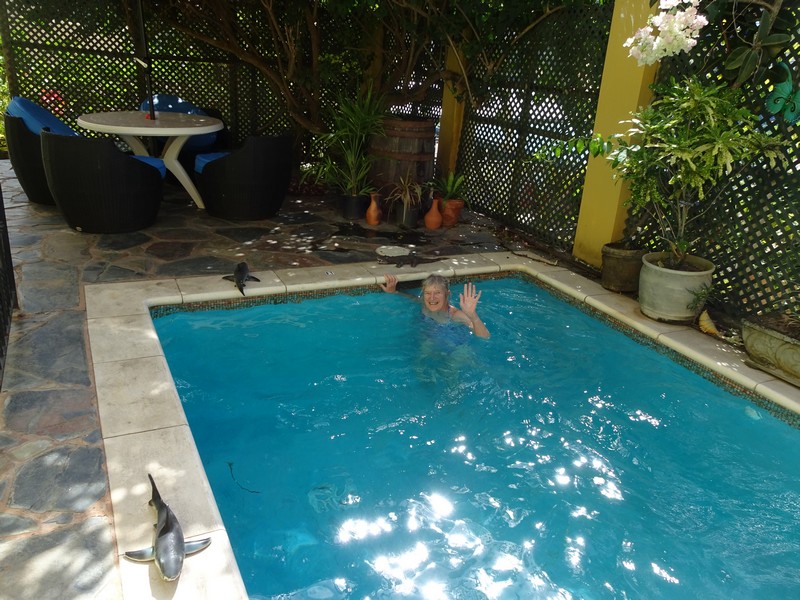
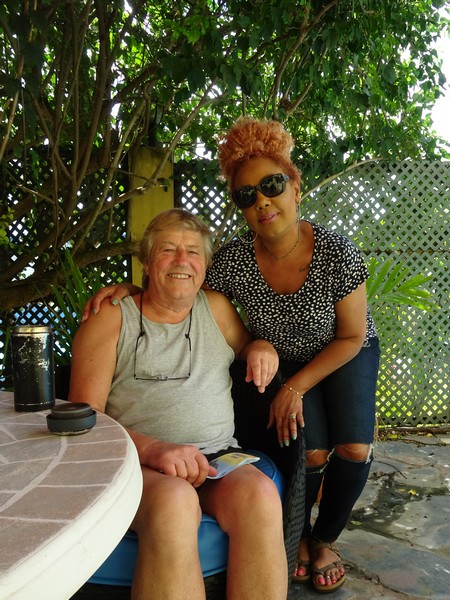
Adrian chats to Arlene after we have a swim in the pool
We continued along the north coast road through the verdant forest, with some lovely views down to sandy bays.
At Blanchisseuse the road turned south. We were pleased to find that we could make this a round trip, even if the road surface was pretty mediocre! We loved driving through the almost untouched forest for mile after mile, with scarcely another vehicle.
At Blanchisseuse the road turned south. We were pleased to find that we could make this a round trip, even if the road surface was pretty mediocre! We loved driving through the almost untouched forest for mile after mile, with scarcely another vehicle.
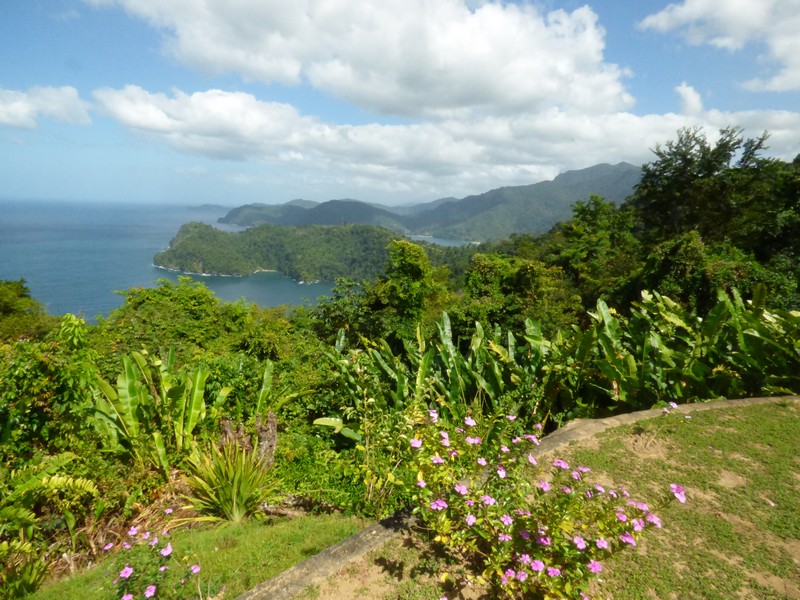
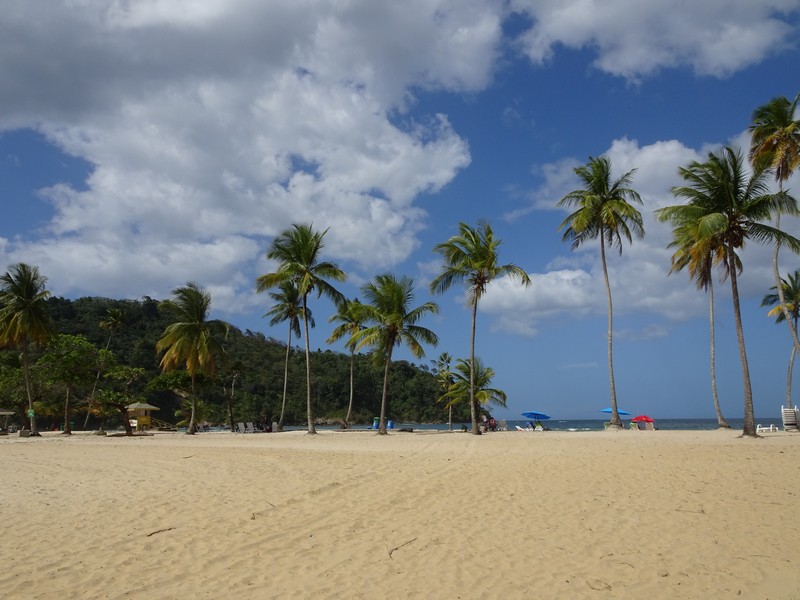
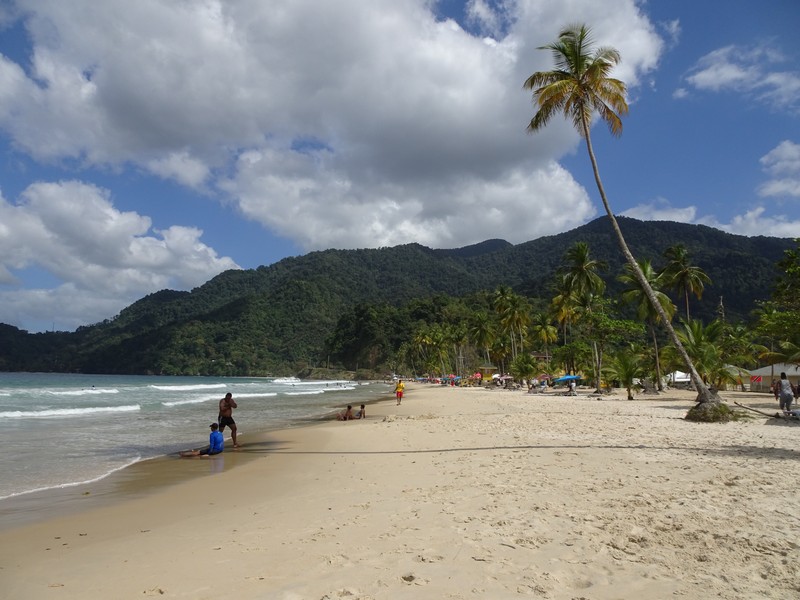
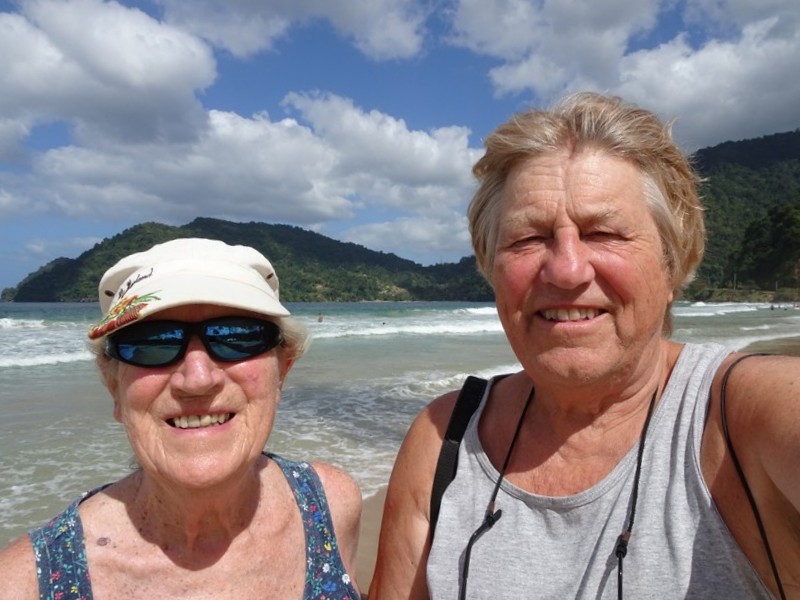
The gorgeous north coast of Trinidad at Maracas
We were bemused in this remote situation to see a man blowing leaves off the road with a modern leafblower!
We passed the Asa Wright reserve, which I want to visit, but it was too late today. The pleasant road continued to frenetic Arima, where we hit the noise and the bustle of urbanisation. Adrian was searching for an ATM – Arlene is another one who wants to be paid cash. Having finally managed to park and find an ATM, it didn’t accept visa! We took the Churchill Roosevelt Highway – not a motorway as it had frustrating traffic lights, where you wait hours. When we turned off at St Joseph’s at 6 o’clock, we were successful in getting cash, so paid Arlene when we got back. They use Trinidad and Tobago dollars here, not Eastern Caribbean dollars.
Adrian had a short swim. Then it was aperitifs on the balcony, followed by pumpkin soup with croutons, before doing more of the Grenada website.
We passed the Asa Wright reserve, which I want to visit, but it was too late today. The pleasant road continued to frenetic Arima, where we hit the noise and the bustle of urbanisation. Adrian was searching for an ATM – Arlene is another one who wants to be paid cash. Having finally managed to park and find an ATM, it didn’t accept visa! We took the Churchill Roosevelt Highway – not a motorway as it had frustrating traffic lights, where you wait hours. When we turned off at St Joseph’s at 6 o’clock, we were successful in getting cash, so paid Arlene when we got back. They use Trinidad and Tobago dollars here, not Eastern Caribbean dollars.
Adrian had a short swim. Then it was aperitifs on the balcony, followed by pumpkin soup with croutons, before doing more of the Grenada website.
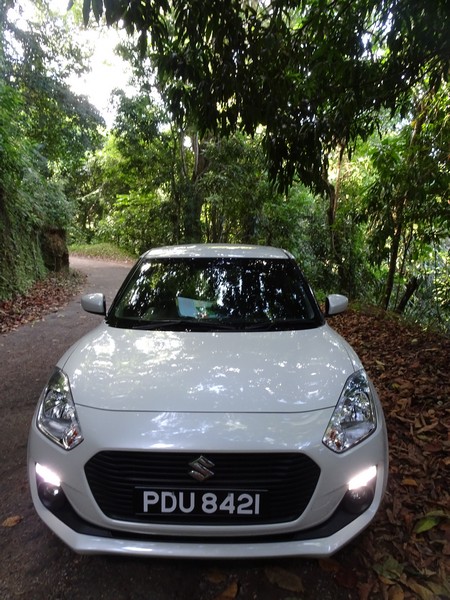
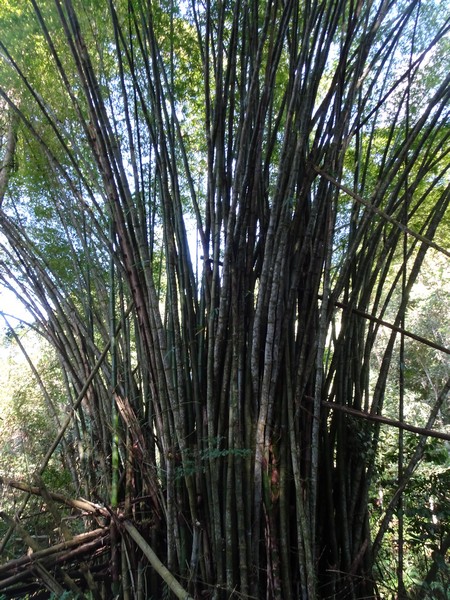
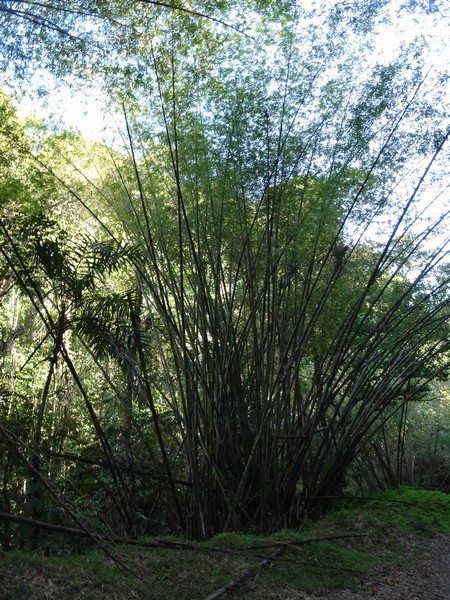
Driving past giant bamboo in the verdant rainforest
Saturday 16th February Black pitch and scarlet ibis 162 km
We were up early and phoned all four of our 'kids' but couldn't get hold of Simon or Tom. We had a swim in the pool before breakfast, which was again OTT. Nice melon, a tuna dish, rolls and more cake.
Adrian had one thing that he wanted to see in Trinidad and that was Pitch Lake - the largest asphalt lake in the world. He remembers learning about it as a child. It is situated in the south of Trinidad, but there is a good motorway for most of the way.
We left at 9.15 and made for the motorway. As we drove along, we both thought that you could be anywhere, and wouldn't guess Trinidad! The last part though was on a bumpy diversion with some official and some incidental topes!
Our first sight of Pitch Lake was unimpressive, as we'd suspected. However, we were 'grabbed' by a local called John who acted as our unasked guide. He led us out over the 'lake', which was thick gooey tar in places, but for most part it was fairly solid. You needed someone to tell you the safe places to walk. If you stand anywhere long enough you will start sinking, and as we drove the car right down to the edge of the lake we had to make sure we parked on the grass or it might not have been there when we got back! An unexpected bonus was the beautiful water lilies thriving in the small pools of water. John gave a continual run of information. They still ‘mine’ the pitch here – about 400 tons a day are dug out and are replaced by upswelling within a few days. An estimated 10 million tons have been removed over the years, but the lake does have a finite life – it’s just that nobody seems to know what it is – or cares! It was used as road asphalt in the past, but much now seems to go to China to make things like battery casings, sealants & paints. The sad part was at the end, when he asked for an exorbitant fee for the 'tour', but at least Adrian had realised his dream of seeing and walking on Pitch Lake.
We were up early and phoned all four of our 'kids' but couldn't get hold of Simon or Tom. We had a swim in the pool before breakfast, which was again OTT. Nice melon, a tuna dish, rolls and more cake.
Adrian had one thing that he wanted to see in Trinidad and that was Pitch Lake - the largest asphalt lake in the world. He remembers learning about it as a child. It is situated in the south of Trinidad, but there is a good motorway for most of the way.
We left at 9.15 and made for the motorway. As we drove along, we both thought that you could be anywhere, and wouldn't guess Trinidad! The last part though was on a bumpy diversion with some official and some incidental topes!
Our first sight of Pitch Lake was unimpressive, as we'd suspected. However, we were 'grabbed' by a local called John who acted as our unasked guide. He led us out over the 'lake', which was thick gooey tar in places, but for most part it was fairly solid. You needed someone to tell you the safe places to walk. If you stand anywhere long enough you will start sinking, and as we drove the car right down to the edge of the lake we had to make sure we parked on the grass or it might not have been there when we got back! An unexpected bonus was the beautiful water lilies thriving in the small pools of water. John gave a continual run of information. They still ‘mine’ the pitch here – about 400 tons a day are dug out and are replaced by upswelling within a few days. An estimated 10 million tons have been removed over the years, but the lake does have a finite life – it’s just that nobody seems to know what it is – or cares! It was used as road asphalt in the past, but much now seems to go to China to make things like battery casings, sealants & paints. The sad part was at the end, when he asked for an exorbitant fee for the 'tour', but at least Adrian had realised his dream of seeing and walking on Pitch Lake.
We stopped at nearby La Brea football field, where we had our elevenses with some of the cake from breakfast, sitting on the stadium seating in the shade. It was warm but really windy.
The road back was very bumpy, mostly due to still being on the Pitch Lake fault and so the road and some houses slowly sink into the ground. It was a bit like the Alaska highway and permafrost melting or ground subsidence due to coal mining. We started driving into San Fernando to get some money, but soon realised that this was a mistake and turned back. We did manage to get some on the outskirts, and also vital water and beer! This is the town in the song ‘Last train to San Fernando’ which was written for a music competition in 1950 although it did not become famous until sung by American Johnny Duncan in 1957 – or for us in the UK, by Lonnie Donnegan. In fact it was not about the last train ever from Port of Spain to San Fernando which was in 1965, but about the last train that night for the person in the song.
We drove down a more than bumpy track ending at a particularity mucky bit by the sea. We sat on the back of the car to eat our sandwich lunch, hearing the happy noise from children enjoying the sea nearby.
We continued north on a straight road through flat country where the houses had a lot of character. Nearby were great oil refineries.
Our next sight was 'The Temple in the Sea' at a place called Waterloo. This Hindu temple was at the end of a walkway in an atmospheric setting almost surrounded by water. It was actually closed, so we just looked from the outside. In the sea were some very ugly 'four eyed fish'.
The road back was very bumpy, mostly due to still being on the Pitch Lake fault and so the road and some houses slowly sink into the ground. It was a bit like the Alaska highway and permafrost melting or ground subsidence due to coal mining. We started driving into San Fernando to get some money, but soon realised that this was a mistake and turned back. We did manage to get some on the outskirts, and also vital water and beer! This is the town in the song ‘Last train to San Fernando’ which was written for a music competition in 1950 although it did not become famous until sung by American Johnny Duncan in 1957 – or for us in the UK, by Lonnie Donnegan. In fact it was not about the last train ever from Port of Spain to San Fernando which was in 1965, but about the last train that night for the person in the song.
We drove down a more than bumpy track ending at a particularity mucky bit by the sea. We sat on the back of the car to eat our sandwich lunch, hearing the happy noise from children enjoying the sea nearby.
We continued north on a straight road through flat country where the houses had a lot of character. Nearby were great oil refineries.
Our next sight was 'The Temple in the Sea' at a place called Waterloo. This Hindu temple was at the end of a walkway in an atmospheric setting almost surrounded by water. It was actually closed, so we just looked from the outside. In the sea were some very ugly 'four eyed fish'.
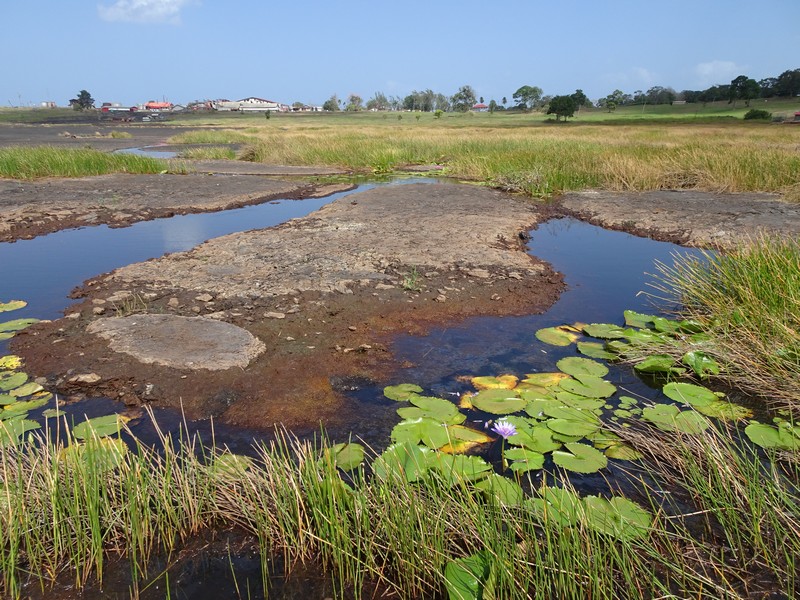
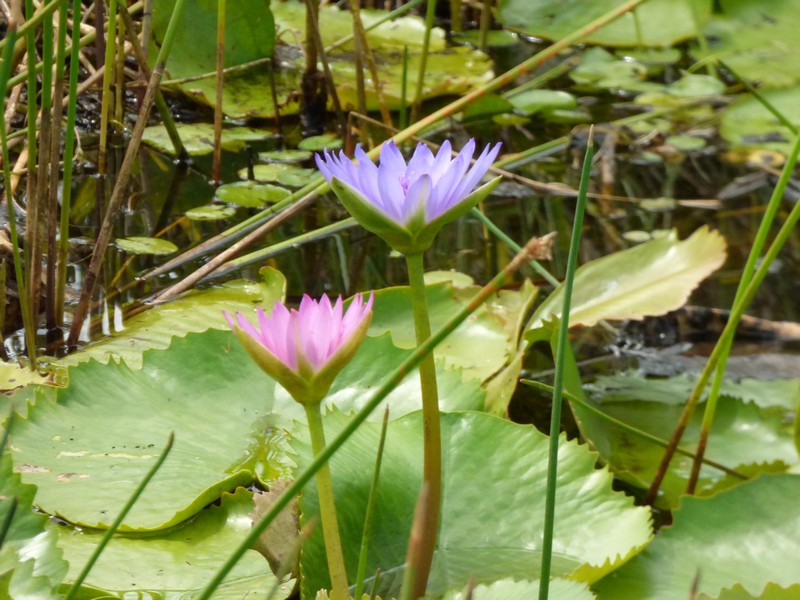
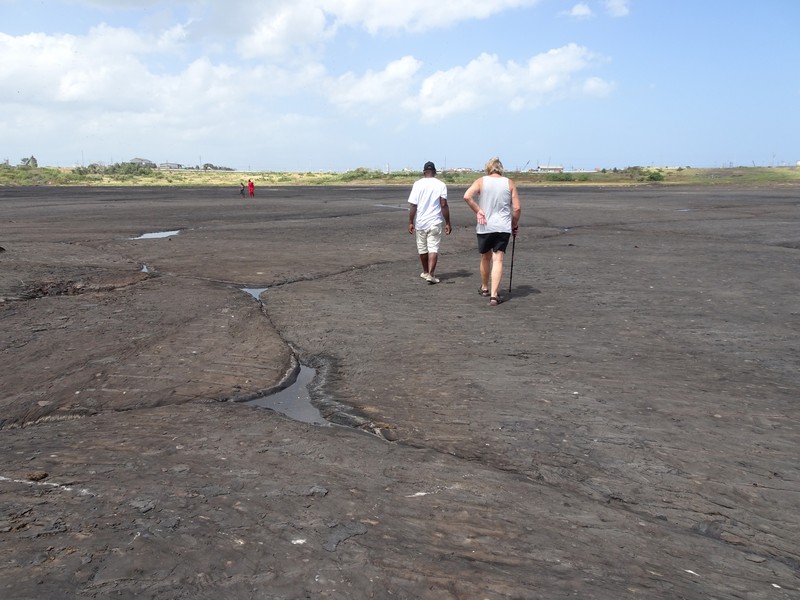
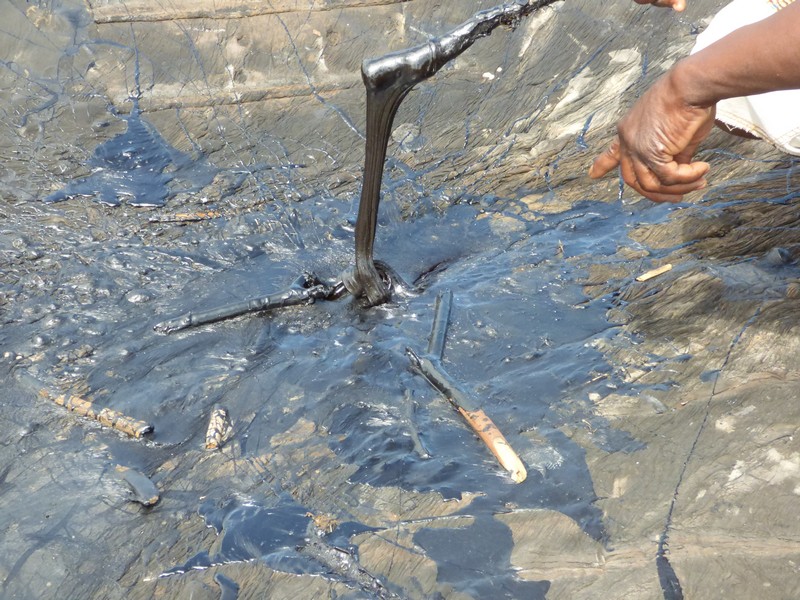
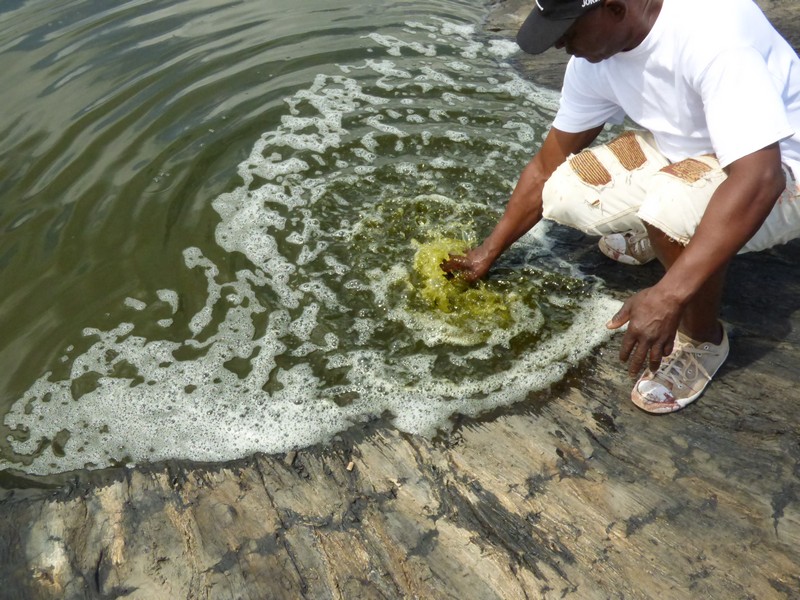
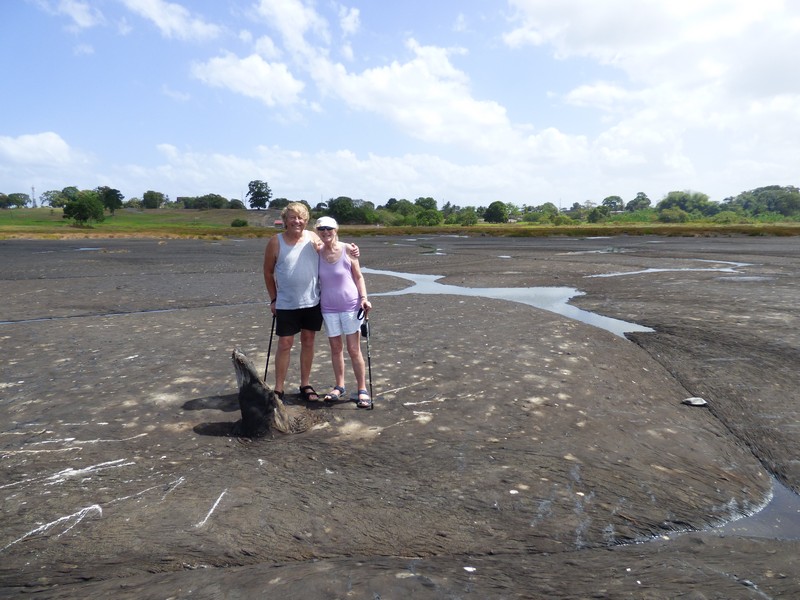
Remarkable Pitch Lake - a dream come true for Adrian
Now it was on to Caroni Swamp for our 4 o'clock boat tour. Apart from the ample bird and wildlife, it is a place where the scarlet ibis gather at dusk. Our boat held about 30 people. The tours would appear to be very popular, as several boats were going out. We were taken down channels surrounded by mangroves, where our guide pointed out many things that we could hardly see, including a tree boa snake wound around a branch, tiny crabs on the aerial roots and small bats on the trunks.
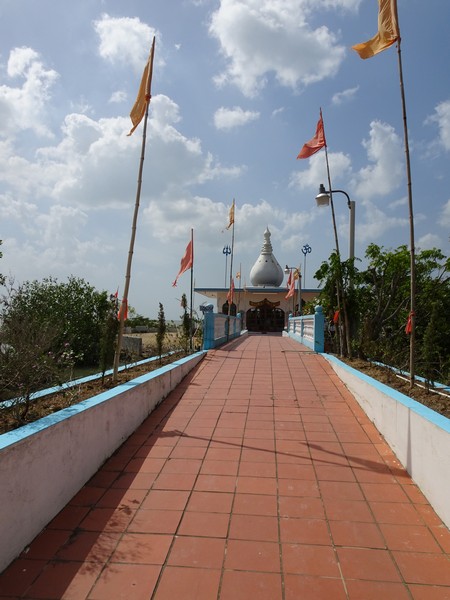
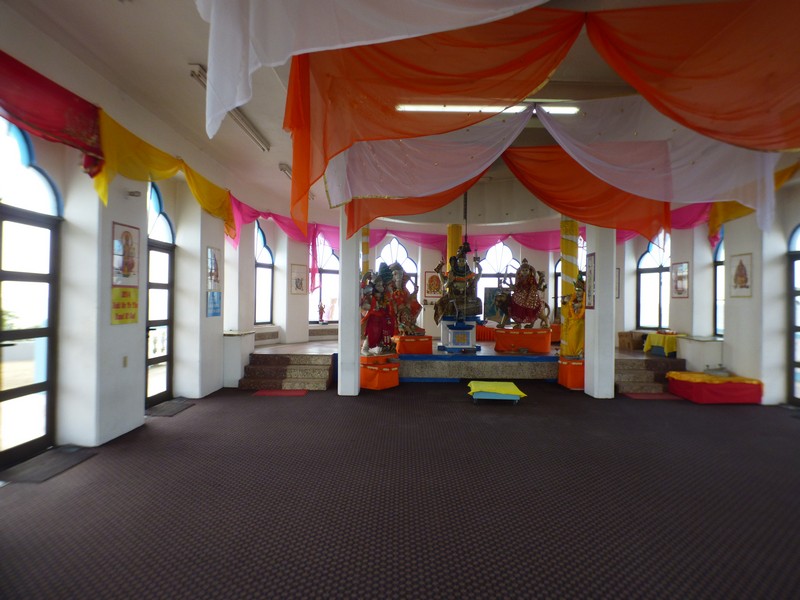
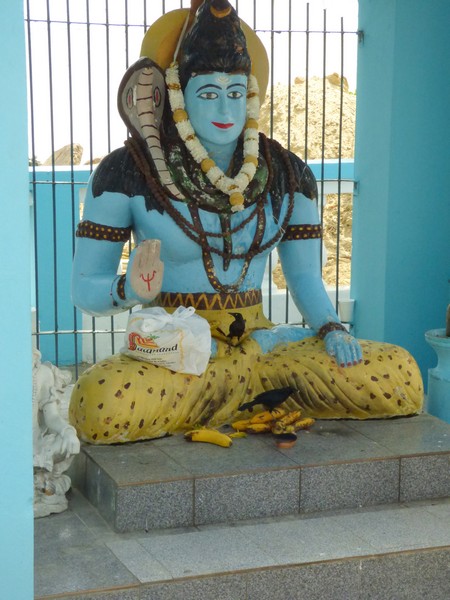
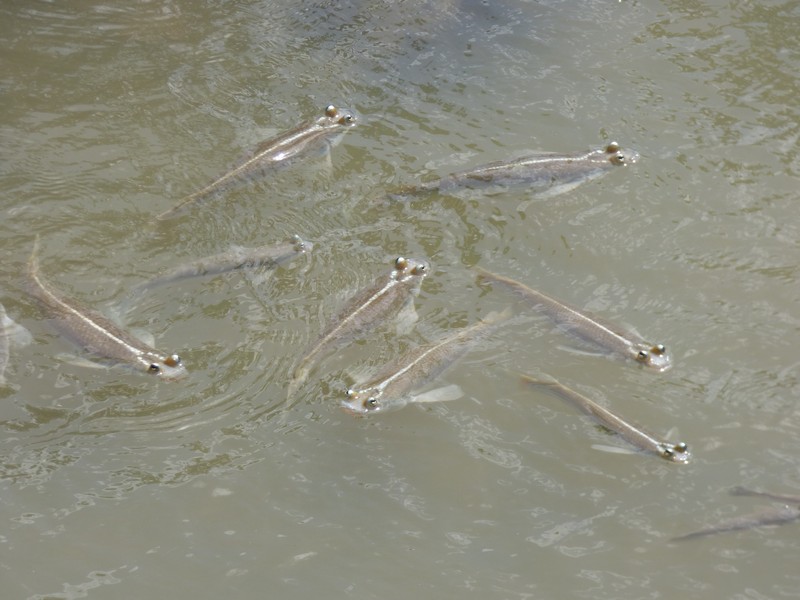
The Temple in the Sea
The climax was coming to open water, where after seeing colourful pink flamingos, we waited to watch the arrival of hundreds of brilliant scarlet ibis to roost in the trees. Their vivid colour made them a sight to treasure. More and more kept arriving, until our guide started back to our mooring place.
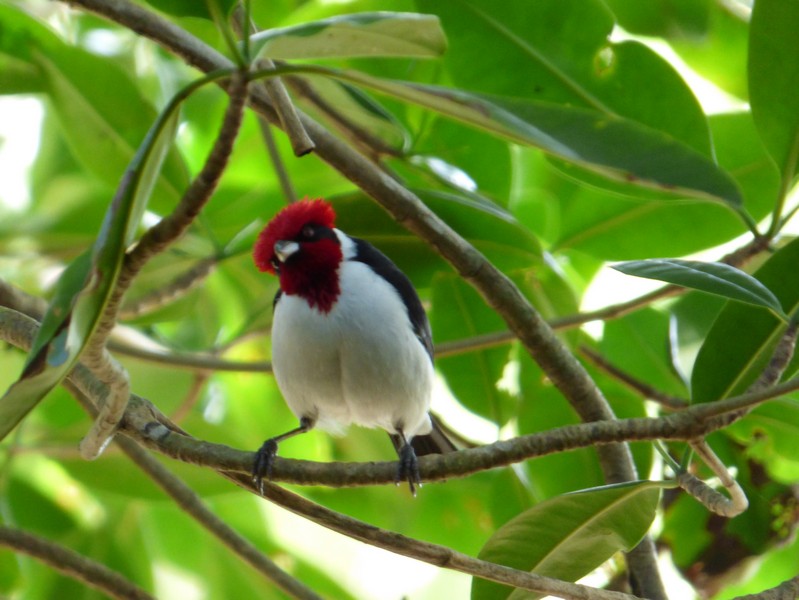
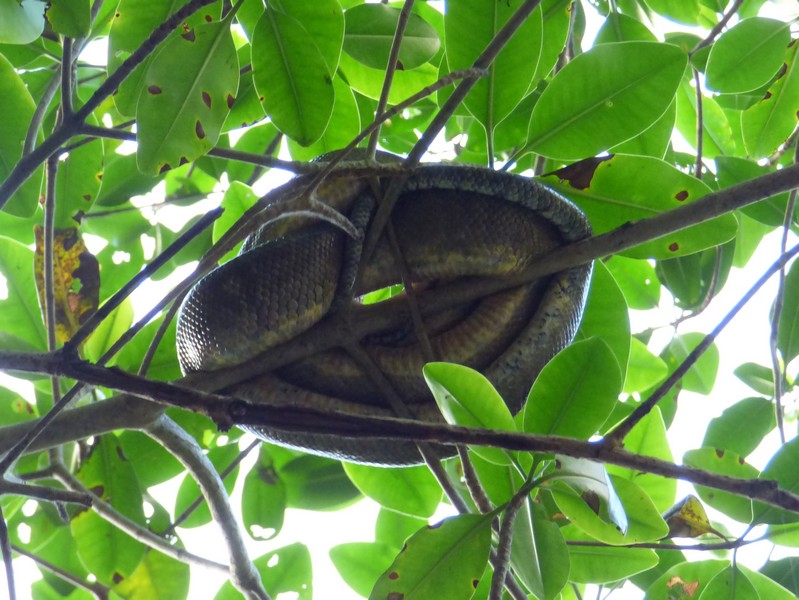
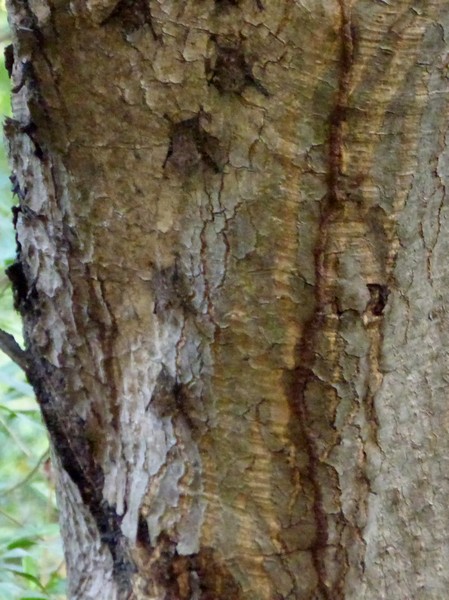
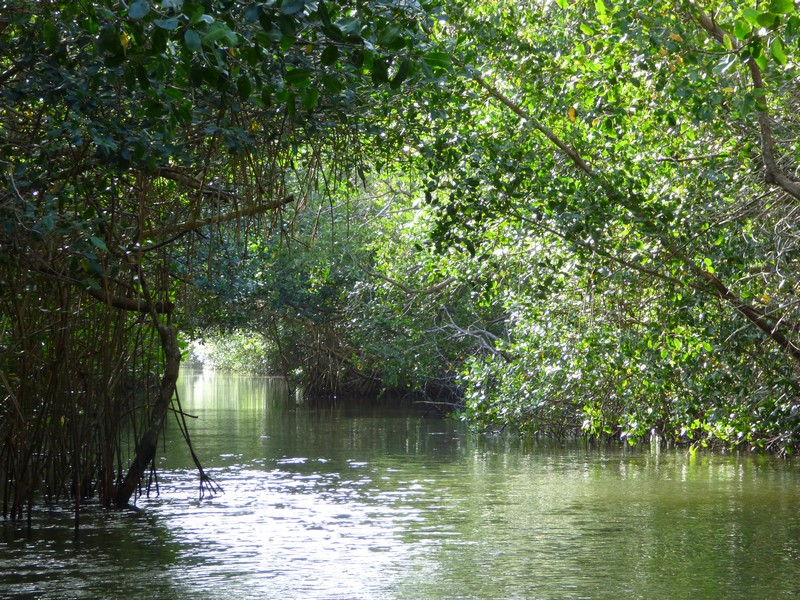
Through the mangroves of the Caroni Swamp, seeing the hidden wildlife - a red cardinal, a tree boa and tiny bats on the trunk
It was now almost dark, so Adrian had the unenviable task of driving us back to Valley Oasis Inn, where we had to unload our stuff before eating melon with a much appreciated drink on the balcony.
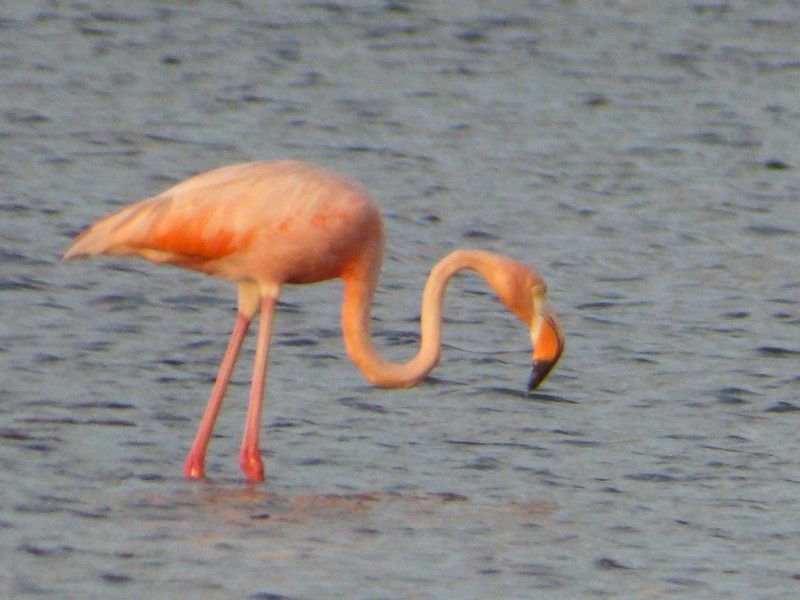
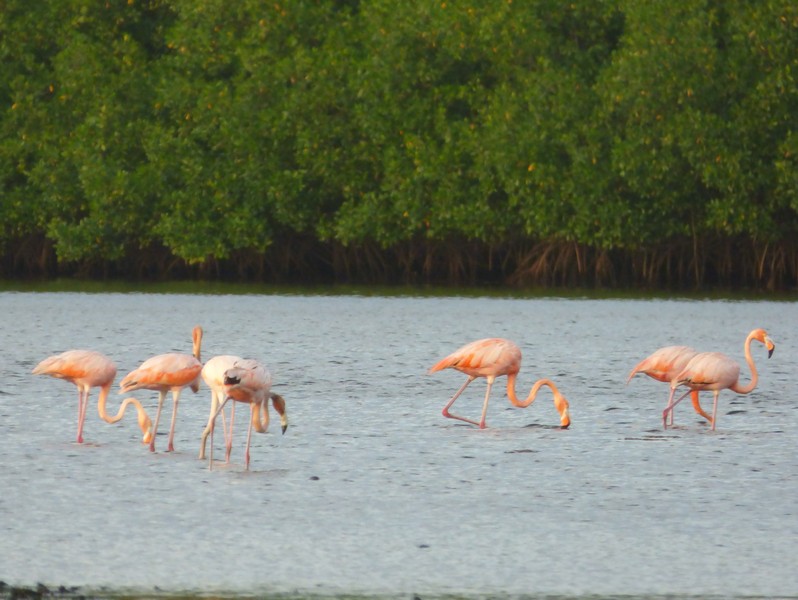
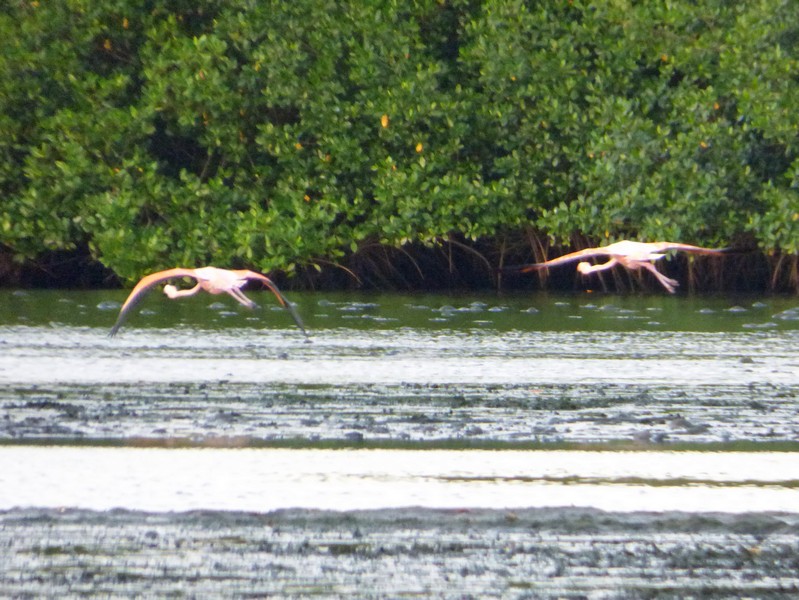
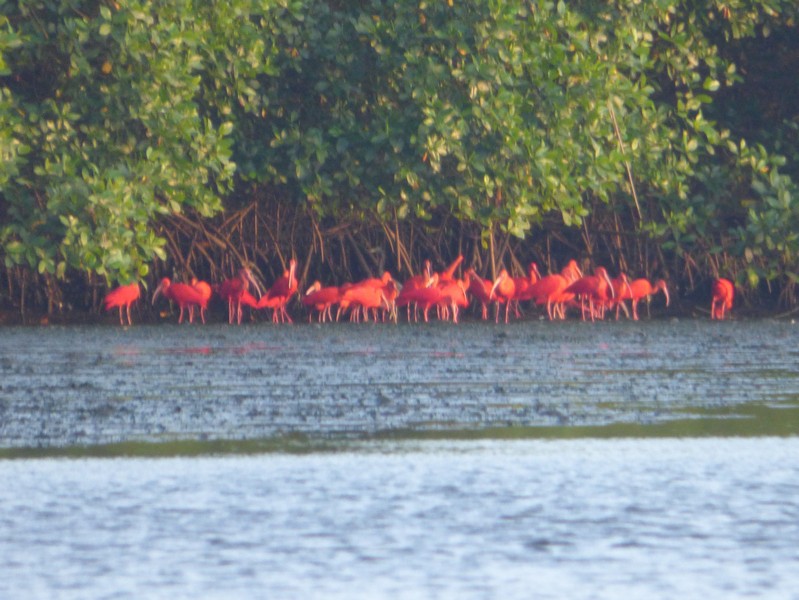
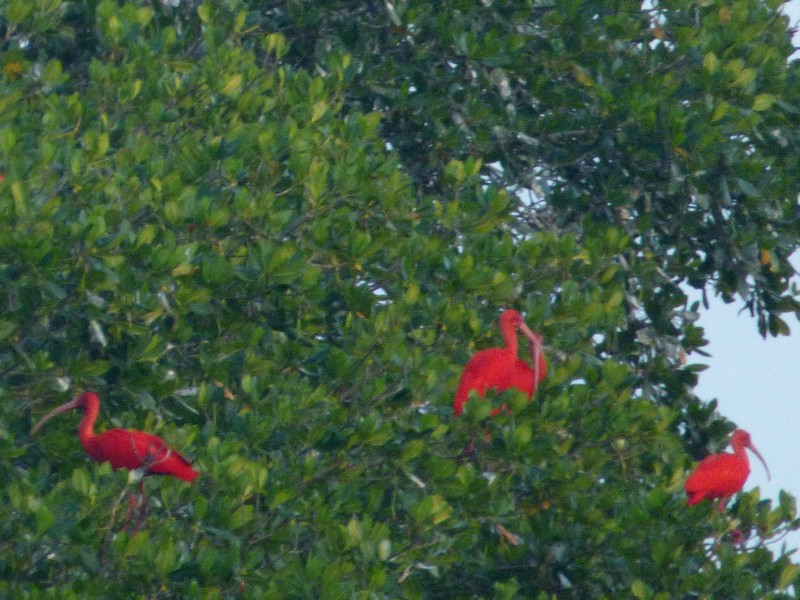
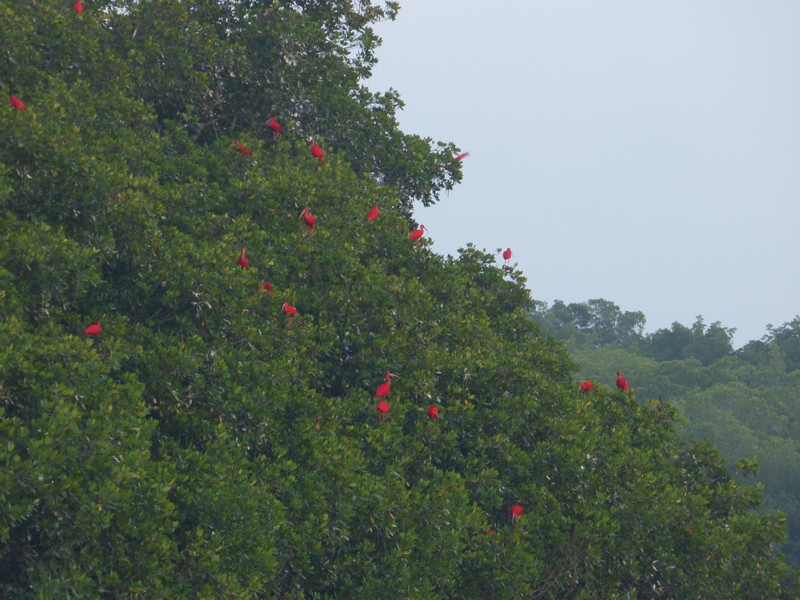
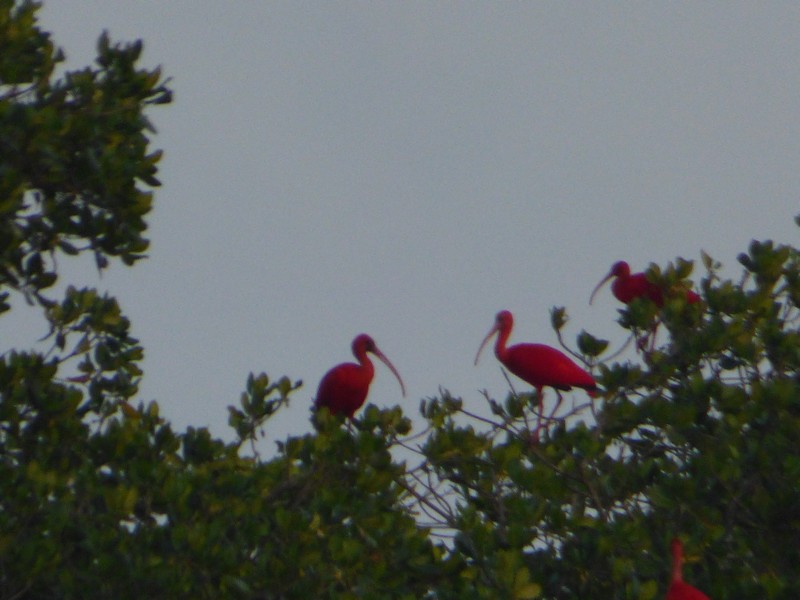
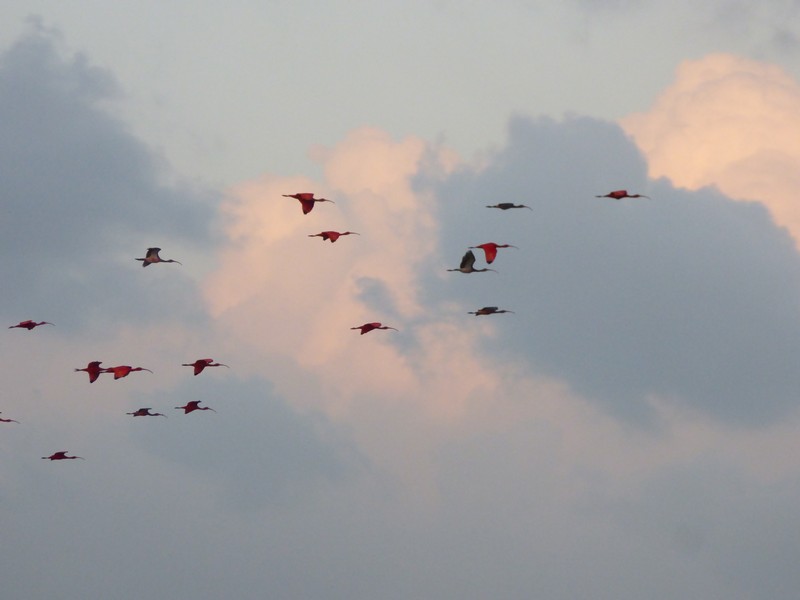
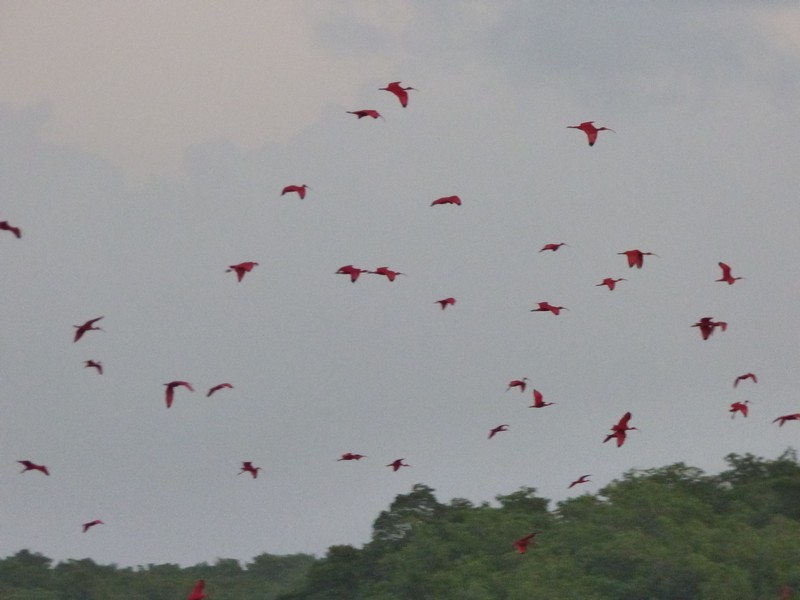
Pretty Flamingoes
Stunning scarlet ibis
Sunday 17th February Sunday in the mountains 62 km
We needed to do some catching up after yesterday! Apart from finishing the website for Grenada and sending the email, we mastered the washing machine and did a load of washing! The machine was extremely noisy. It has a tumble drier badly placed above and seemingly unnecessary here, but there is nowhere to hang things.
Khristian brought up our breakfast, including a large Spanish omelet each, and more melon and cake. We phoned Tom. They were just sitting down to lunch, having been for a walk. (It was 3.00pm in Spain!)
We sent our email for the Grenada website. It was too hot to sit on the balcony with our coffee, and was late morning when we left. We had intended going to the Asa Wright Nature Centre, but ended up on the wrong road going up into the mountains. Adrian's sat-nav showed a way through, although there was no road shown on the map. Our road took us to Lopinot and on, deteriorating by the moment. It concertinaed round and round and up and down, with varying road surface of bad! When we'd got to about a mile from the end, we asked a man in a parked van. He said no - the road didn't go unless you had a 4x4. We were very aware of this brand new hire car, and knew that we had to turn round!
So no Asa Wright centre today! Instead we slowly made our way back to Lopinot on the dodgy road. It was marked on the map as being a historic site, and was in fact a former cocoa plantation, owned by a Frenchman. It was now a pleasant picnic area, with gigantic trees, with bromeliads growing from them. We sat in the shade to eat our lunch.
We needed to do some catching up after yesterday! Apart from finishing the website for Grenada and sending the email, we mastered the washing machine and did a load of washing! The machine was extremely noisy. It has a tumble drier badly placed above and seemingly unnecessary here, but there is nowhere to hang things.
Khristian brought up our breakfast, including a large Spanish omelet each, and more melon and cake. We phoned Tom. They were just sitting down to lunch, having been for a walk. (It was 3.00pm in Spain!)
We sent our email for the Grenada website. It was too hot to sit on the balcony with our coffee, and was late morning when we left. We had intended going to the Asa Wright Nature Centre, but ended up on the wrong road going up into the mountains. Adrian's sat-nav showed a way through, although there was no road shown on the map. Our road took us to Lopinot and on, deteriorating by the moment. It concertinaed round and round and up and down, with varying road surface of bad! When we'd got to about a mile from the end, we asked a man in a parked van. He said no - the road didn't go unless you had a 4x4. We were very aware of this brand new hire car, and knew that we had to turn round!
So no Asa Wright centre today! Instead we slowly made our way back to Lopinot on the dodgy road. It was marked on the map as being a historic site, and was in fact a former cocoa plantation, owned by a Frenchman. It was now a pleasant picnic area, with gigantic trees, with bromeliads growing from them. We sat in the shade to eat our lunch.
Hearing music playing loudly, we thought that it was live, so walked down to see. In fact it was just a group of people enjoying their music too loudly! Nearby, several children were enjoying swimming in a natural pool. We decided to walk back by the road, and found that it was further than we thought in the heat!
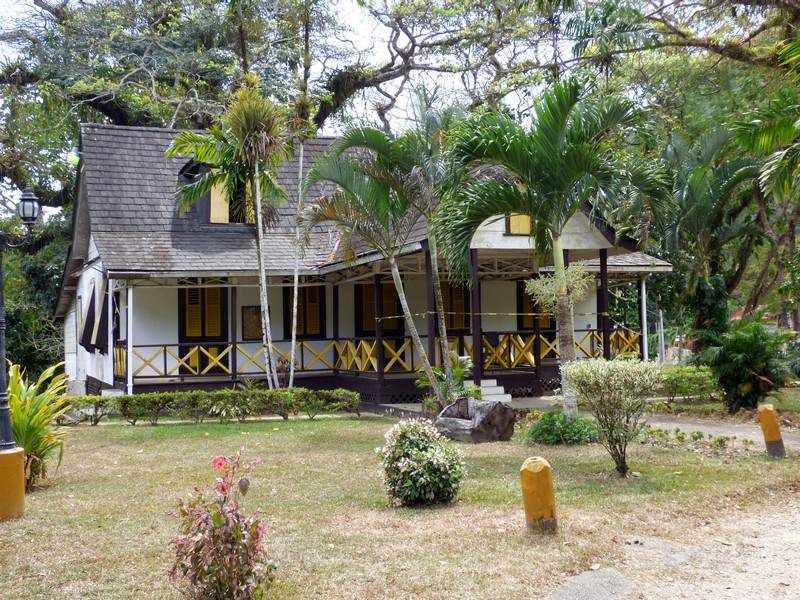
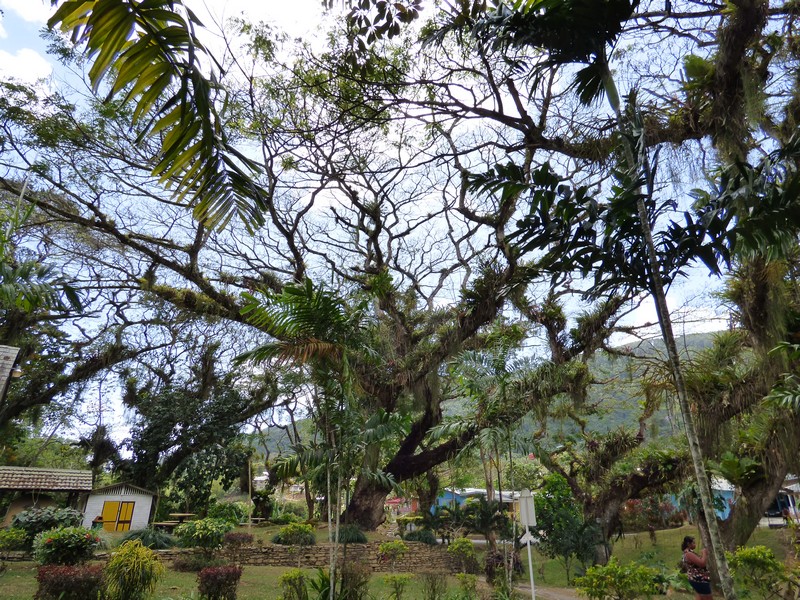
The former cocoa plantation of Lopinot
The village of Lopinot had a large playing field. On it we saw a very strange sign - it said that the breeding of mosquitoes was punishable by fine!
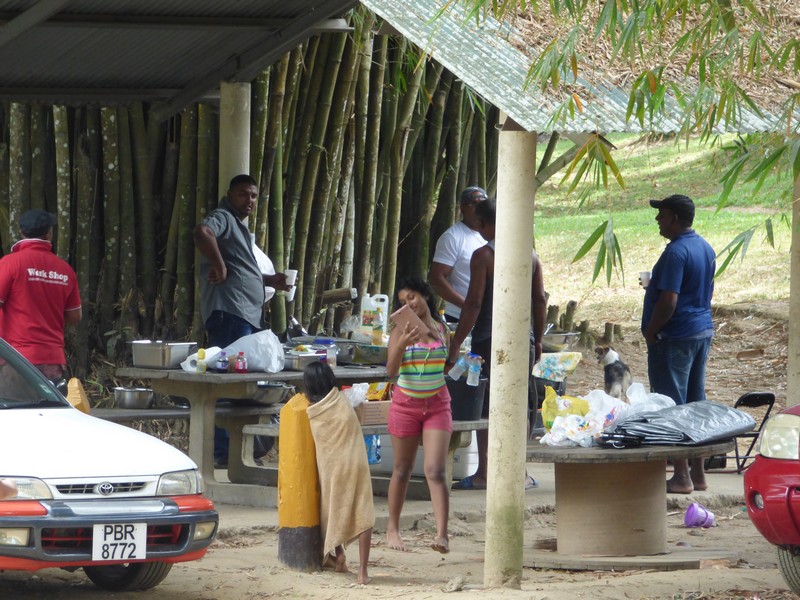
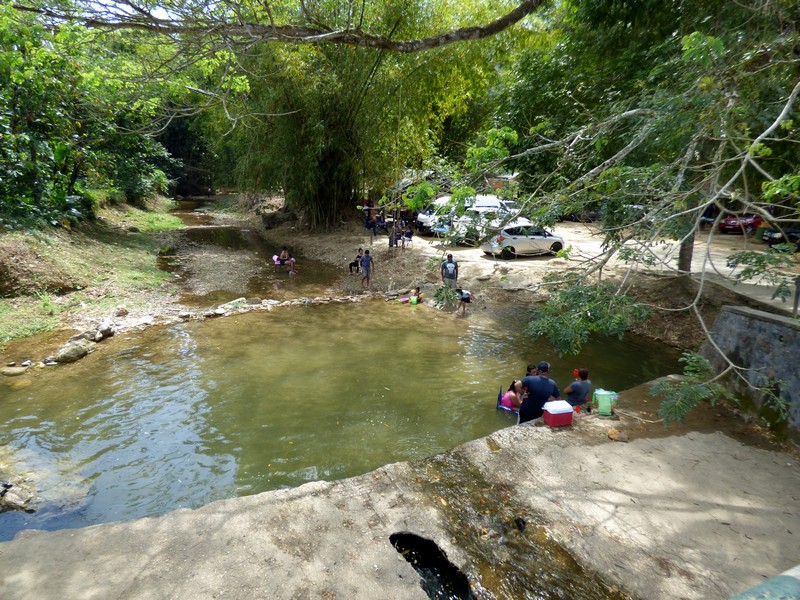
Sunday afternoon revelries
We were surprised at the number of vehicles which passed us on this grotty little road which led nowhere - just to one more village after Lopinot. We never discovered why - maybe just Sunday picnics, but what a road!
We returned down the mountain road, Adrian cleverly following minor roads back, avoiding the busy roads. It was fine except for the topes, and the time the sat nav took us to a near vertical edge loosely called a road!
We were heading for St Benedicts Monastery, set high in the hills, with a supposedly good view. When we finally reached it, there were quite a lot of people about, mostly of Asian descent, sitting along a sort of balcony. A service was taking place in the church.
We returned down the mountain road, Adrian cleverly following minor roads back, avoiding the busy roads. It was fine except for the topes, and the time the sat nav took us to a near vertical edge loosely called a road!
We were heading for St Benedicts Monastery, set high in the hills, with a supposedly good view. When we finally reached it, there were quite a lot of people about, mostly of Asian descent, sitting along a sort of balcony. A service was taking place in the church.
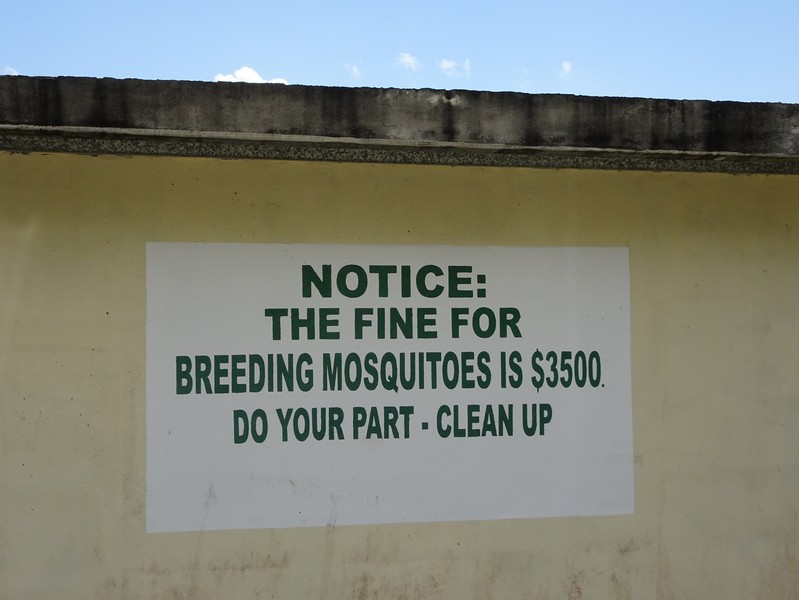
Outside it was very windy, so we stopped under a large tree in the nearby seminary to have a cup of tea before returning to Valley Oasis Inn for our last night here.
One of the first things to do was to have a swim in the nice little pool.
We sat on the balcony for aperitifs, then ate our meal by the pool. We were both feeling a bit weary.
One of the first things to do was to have a swim in the nice little pool.
We sat on the balcony for aperitifs, then ate our meal by the pool. We were both feeling a bit weary.
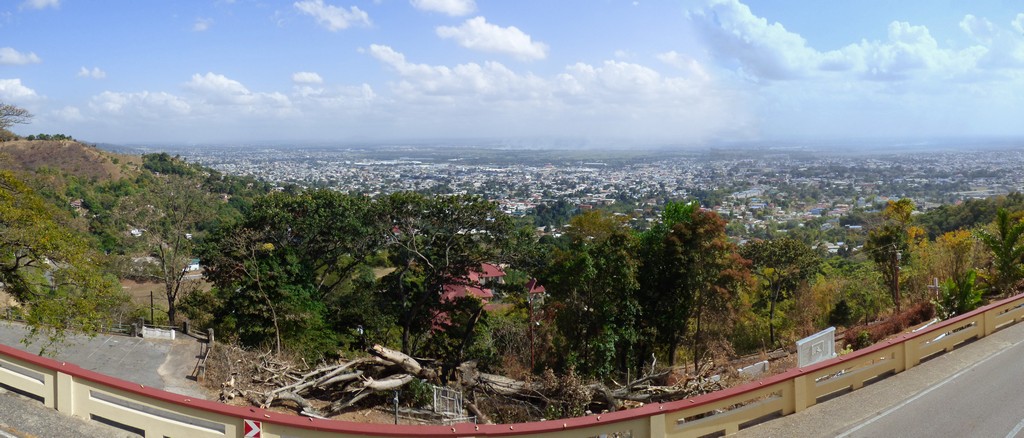
Looking down from St Benedict's Monastery

Relaxing by the pool
Monday 18th February South after watching lots of humming birds 116km
We were up early to get organised to drive to the south of Trinidad for three days. Packing up always takes a long time.
We had a swim in the pleasant little 'private pool' before breakfast. We then brought the tasty Spanish omelet down to eat by the pool. The rest of the food we kept for later. The breakfasts here have been more than generous.
We were up early to get organised to drive to the south of Trinidad for three days. Packing up always takes a long time.
We had a swim in the pleasant little 'private pool' before breakfast. We then brought the tasty Spanish omelet down to eat by the pool. The rest of the food we kept for later. The breakfasts here have been more than generous.
When we were ready to leave, Khristian helped us down with our bags. His stature reminded me of Laure's brother Gerard. Arlene had left for an appointment, but had asked that we email when we get to our next place.
We needed to get fuel and to buy some shopping, as we didn't expect to find much where we're going. On our way we passed a man with the longest hair I've ever seen - it was loosely plaited, and came down past his knees!
We got a blue badge parking place right outside Massy's. Inside it was 'messy Massy's' - they were refilling shelves after the weekend, and groups of workers were bunging up the aisles. We found the staff very offhand - take it or leave it.
The petrol station was similarly difficult - we waited ages (chose the wrong queue again). Adrian was concerned that they might not take visa card, so he went to ask. ‘Yes she said’. So back to the pump went Adrian. When the fuel didn't work, another employee said that you had to pay beforehand. So back to the tiny window where the lady sat inside almost in darkness. It was impossible to hear what she was saying (for Adrian anyway). She wanted him to pay the full amount beforehand. ‘But I don’t know how much I want’. ‘Is your tank empty’ – ‘yes’ and she put a sum on Adrian’s card. After refilling he went back, she said something and then gave him change in cash!
Now we set off on the long trail to Asa Wright Nature Centre - third time lucky. After the unpleasant drive through the nice sounding town of Arima (again), the road wound on into the wonderful rainforest, getting better and better the further you went.
The drive into the entrance building was long, winding through the huge trees and giant bamboo. The building had a large veranda, where you could sit and look out to the many feeding stations where dozens of birds came to feed. They all loved the melon which was put out. There were humming birds of all sorts, plus all kinds of other birds. Adrian was snapping away, with the hope of identifying the birds later.
We needed to get fuel and to buy some shopping, as we didn't expect to find much where we're going. On our way we passed a man with the longest hair I've ever seen - it was loosely plaited, and came down past his knees!
We got a blue badge parking place right outside Massy's. Inside it was 'messy Massy's' - they were refilling shelves after the weekend, and groups of workers were bunging up the aisles. We found the staff very offhand - take it or leave it.
The petrol station was similarly difficult - we waited ages (chose the wrong queue again). Adrian was concerned that they might not take visa card, so he went to ask. ‘Yes she said’. So back to the pump went Adrian. When the fuel didn't work, another employee said that you had to pay beforehand. So back to the tiny window where the lady sat inside almost in darkness. It was impossible to hear what she was saying (for Adrian anyway). She wanted him to pay the full amount beforehand. ‘But I don’t know how much I want’. ‘Is your tank empty’ – ‘yes’ and she put a sum on Adrian’s card. After refilling he went back, she said something and then gave him change in cash!
Now we set off on the long trail to Asa Wright Nature Centre - third time lucky. After the unpleasant drive through the nice sounding town of Arima (again), the road wound on into the wonderful rainforest, getting better and better the further you went.
The drive into the entrance building was long, winding through the huge trees and giant bamboo. The building had a large veranda, where you could sit and look out to the many feeding stations where dozens of birds came to feed. They all loved the melon which was put out. There were humming birds of all sorts, plus all kinds of other birds. Adrian was snapping away, with the hope of identifying the birds later.
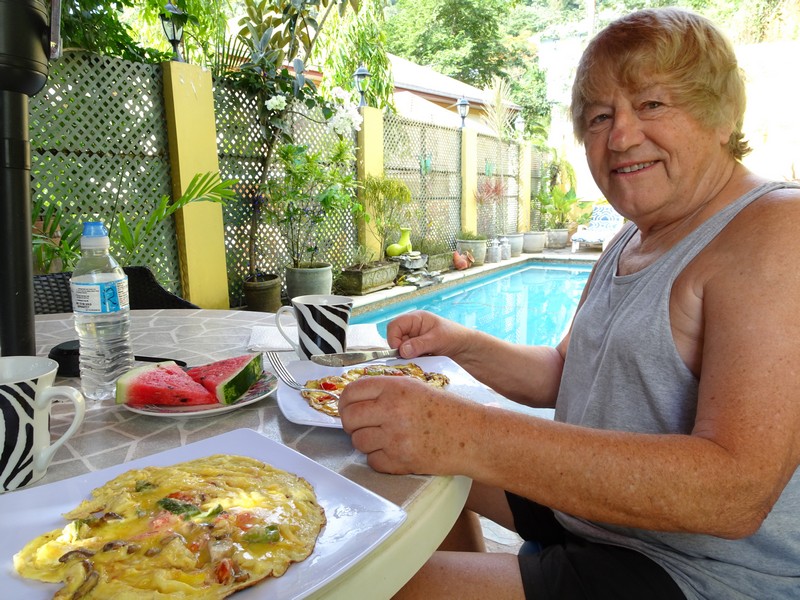
Breakfast by the pool
We found the place to be rather smart, with 'nice' visitors. You can stay here, and be led by guides around the vast grounds - off limits to day visitors like us unless you went on a tour. We felt a bit out of place - not correctly dressed, as it were. Nobody spoke to us. Still we enjoyed the sightings.
We walked back to the car, and ate our meagre sandwich sitting on a kerb in the shady car park, listening to the exotic bird sound (all the others there had lunch on the veranda).
As we left at 1.30, we drove past two fantastic white daturas in the drive.
We walked back to the car, and ate our meagre sandwich sitting on a kerb in the shady car park, listening to the exotic bird sound (all the others there had lunch on the veranda).
As we left at 1.30, we drove past two fantastic white daturas in the drive.
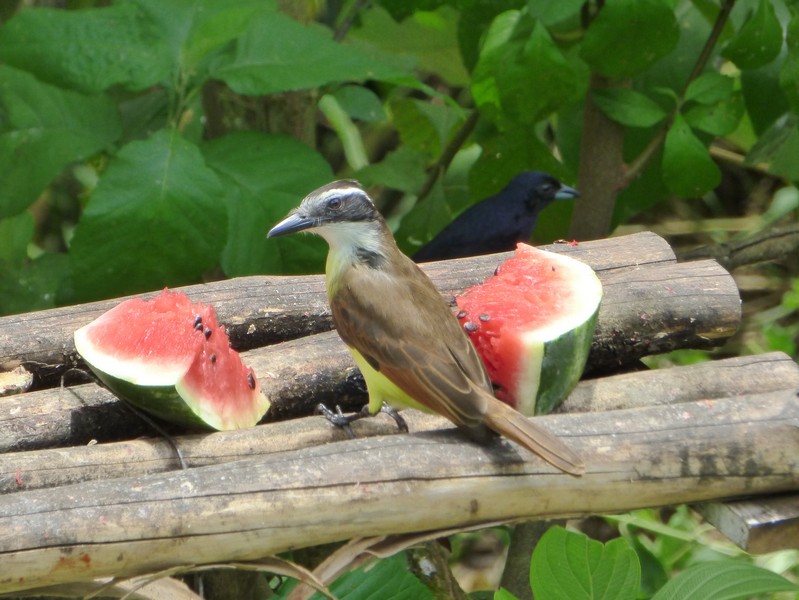
.jpg)
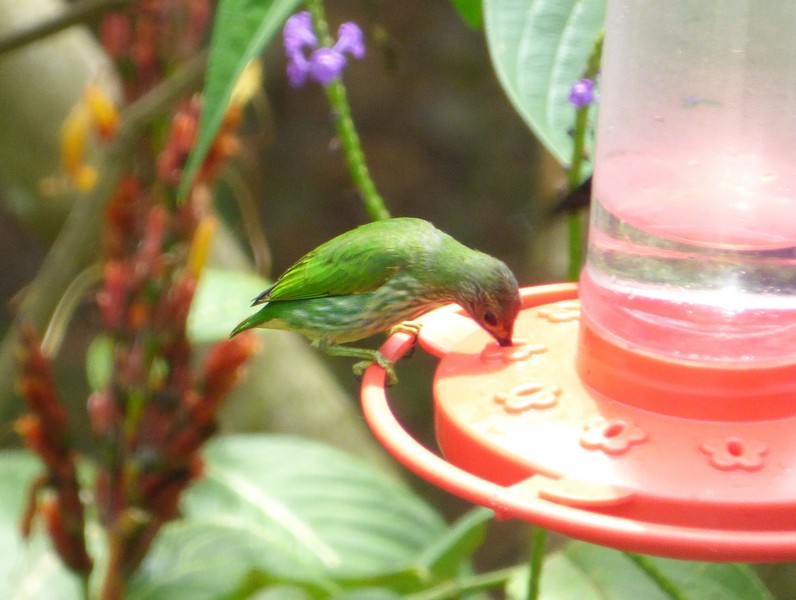
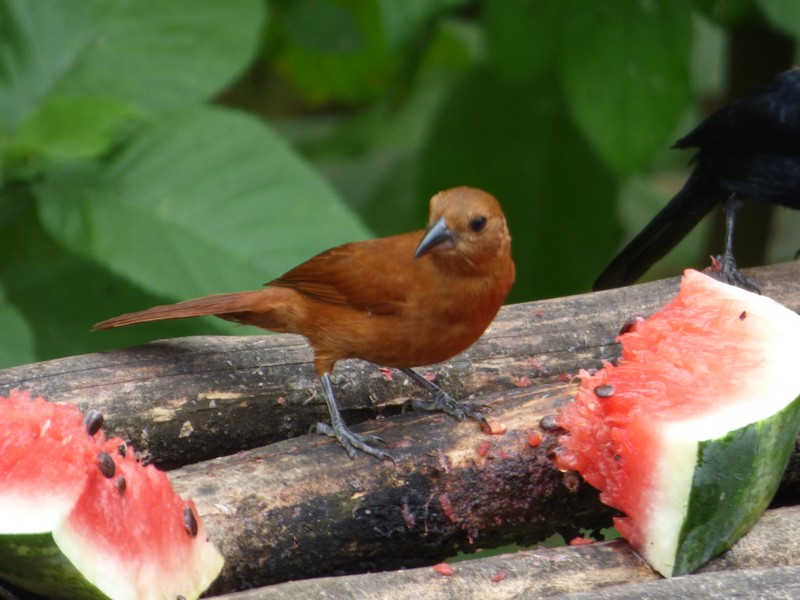
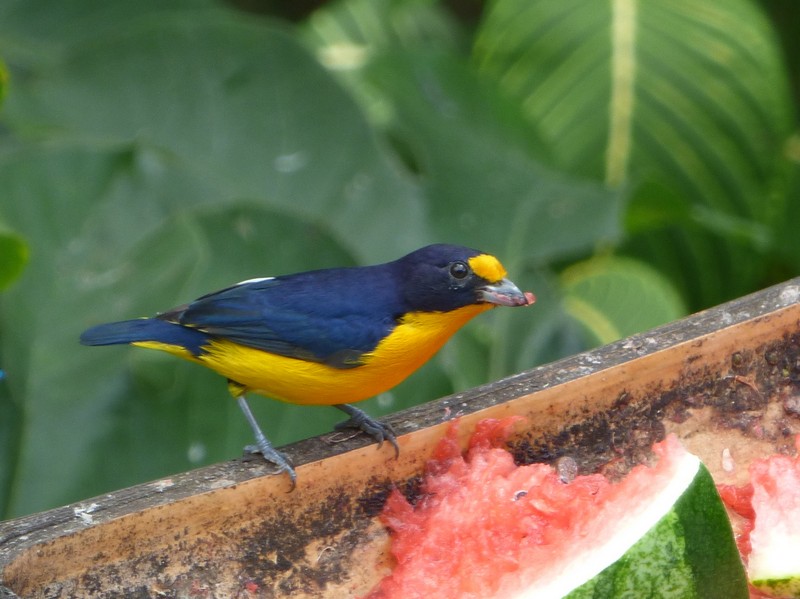
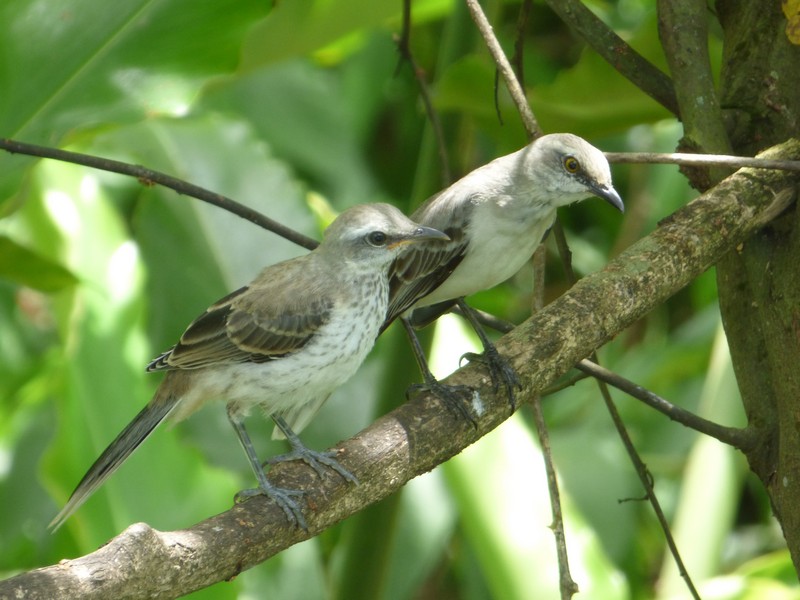
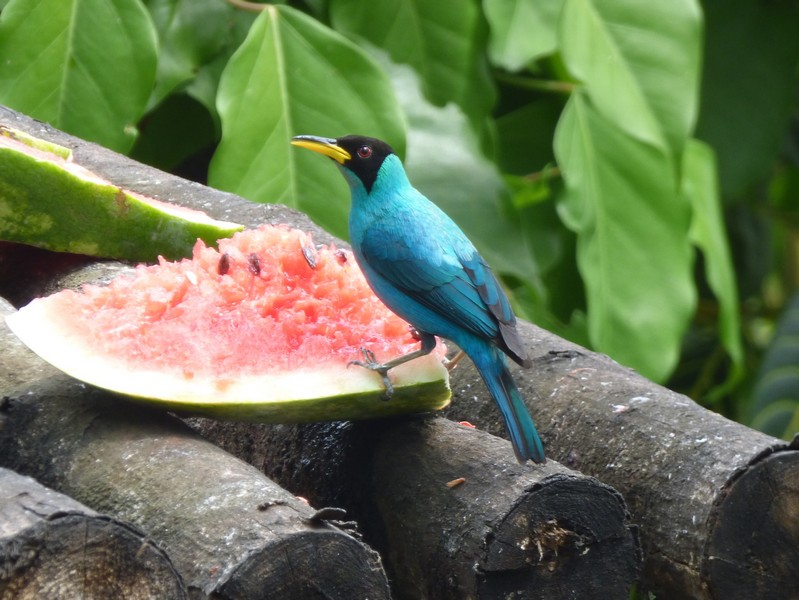
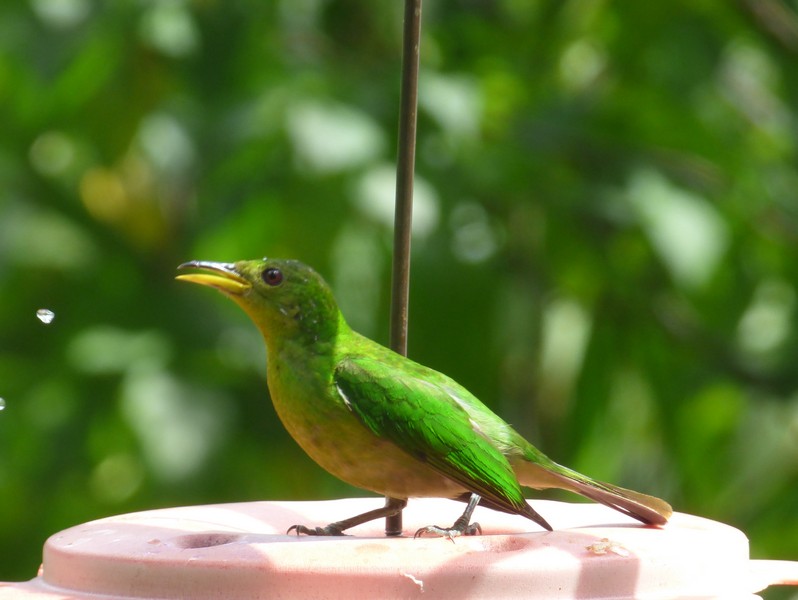
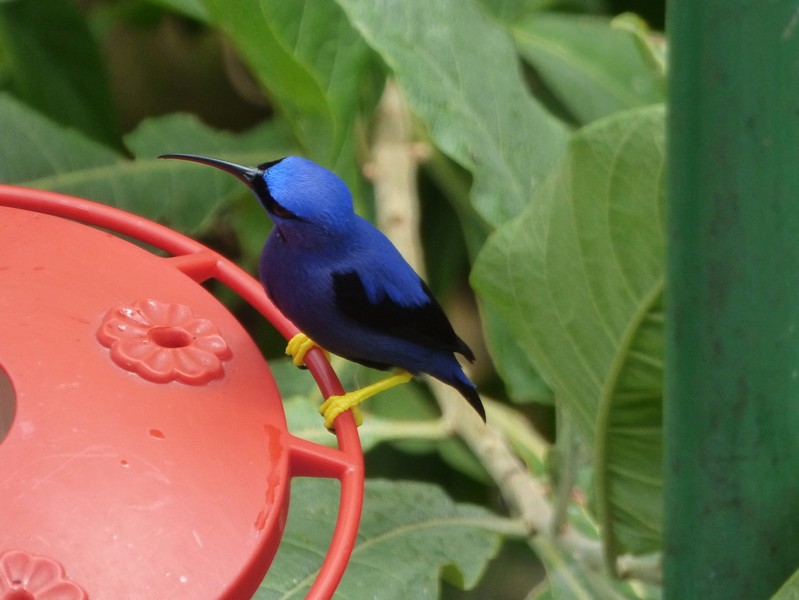
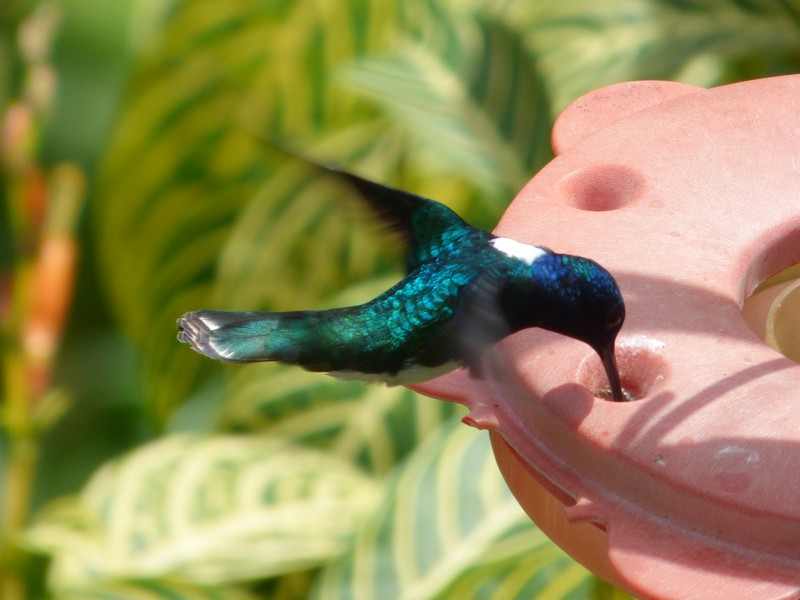
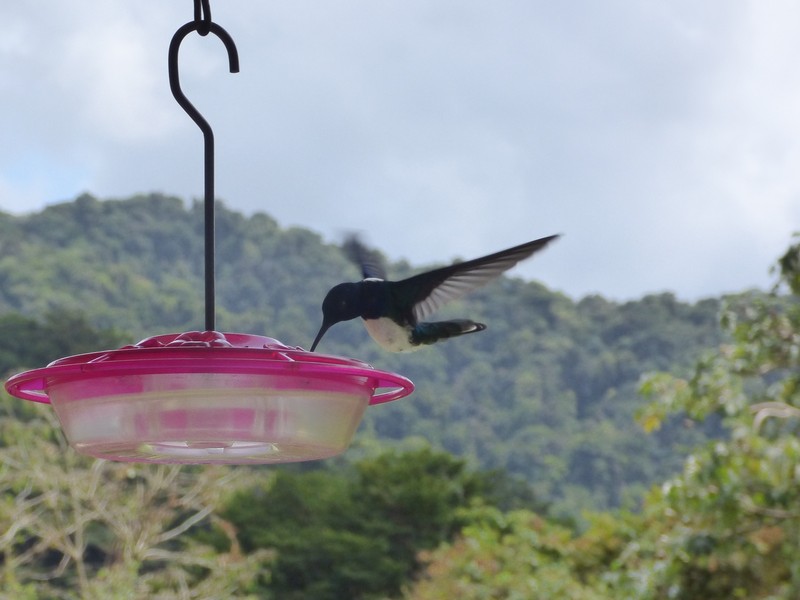
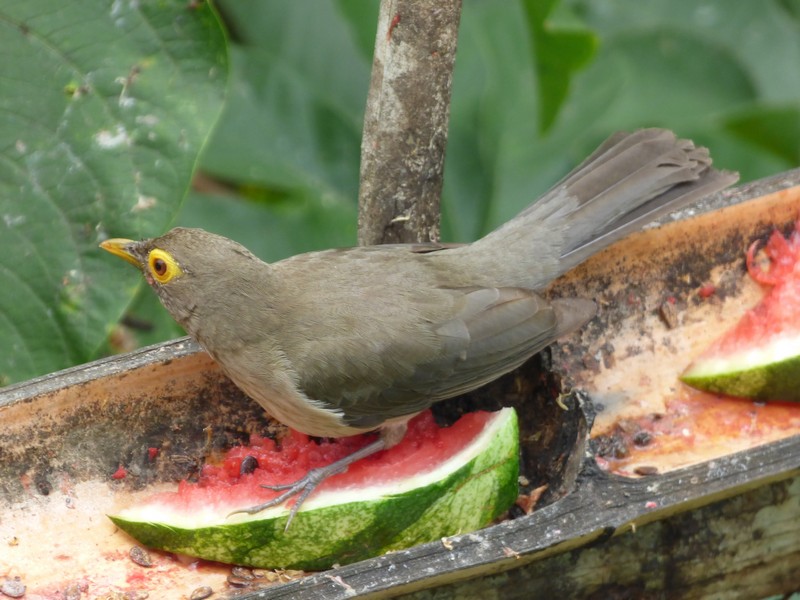
Some of the birds we saw at the Asa Wright Nature Centre
Our route now took us through the town of Sangre Grande, known as Sandy Grandy, but to me Andy Pandy!
It was busy and slow driving through the town, but it had a happy feel. I enjoyed seeing the school children walking along, all in their different uniforms.
After a long drag, we finally reached the sea. From here it was a 25km drive along the coconut palm fringed road to Mayaro. The area is known as Cocal, and is very lovely, with the waves crashing on to the beach to one side. The air smelt warm.
It was busy and slow driving through the town, but it had a happy feel. I enjoyed seeing the school children walking along, all in their different uniforms.
After a long drag, we finally reached the sea. From here it was a 25km drive along the coconut palm fringed road to Mayaro. The area is known as Cocal, and is very lovely, with the waves crashing on to the beach to one side. The air smelt warm.
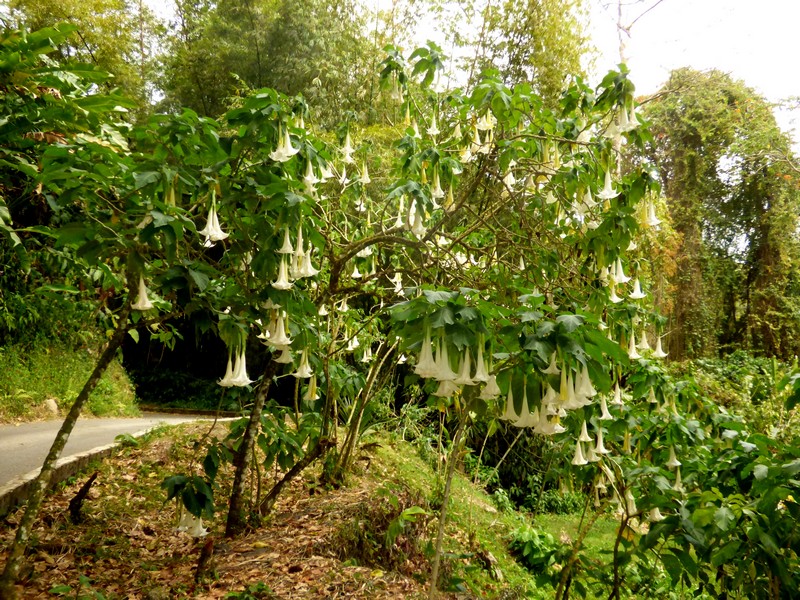
White Datura dripping with flowers
We looked at the golden sandy beach at Mayaro, with its coconut palms, rough sea, seaweed and little white boats.
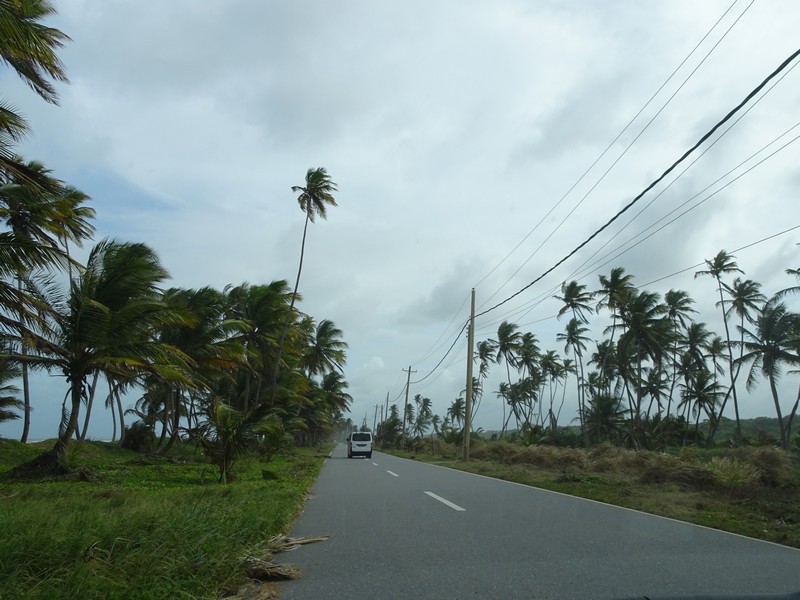
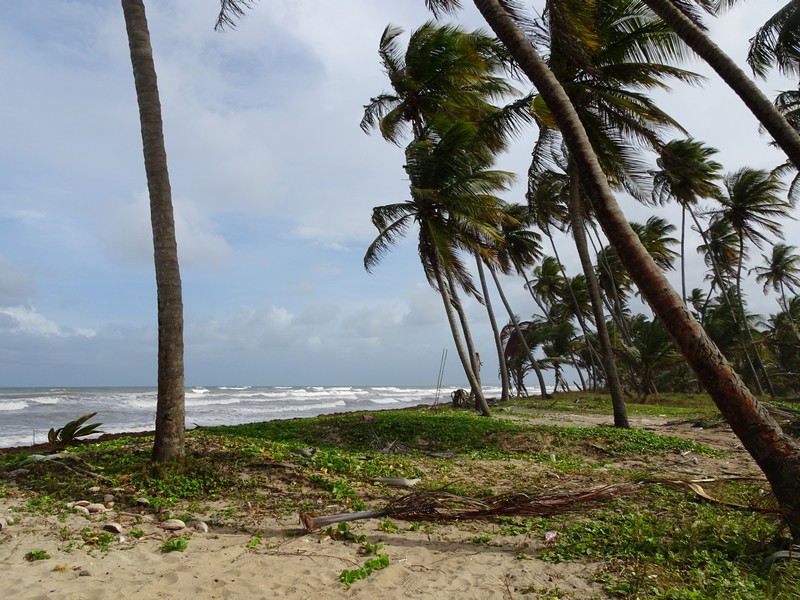
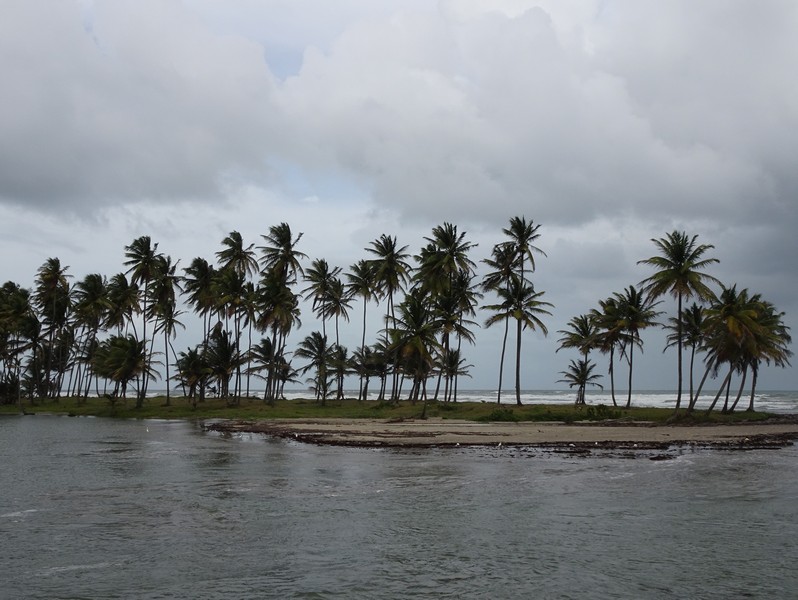
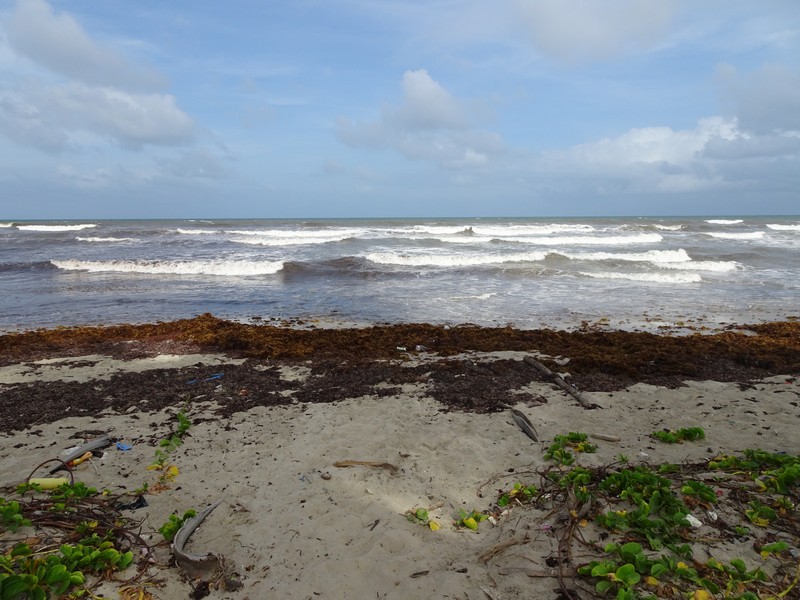
The Cocal area of coconut palms and beach
We were looking for the house which we had booked - but this one didn't even have a name! The given sat-nav position was wrong again so we drove around the small lanes, trying to match it up with a tiny photo on the computer! Just as I thought I'd spotted it, a man said 'Adrian'.
We were welcomed by Danpaul, known as 'Joe', and his 'friend', a lady called Jaya. At that moment there was an unexpected short torrential shower of rain. 'There won't be any more' they said, 'this is the dry season', but in fact there was another in the evening and again in the night.
We all settled on the veranda. Joe lived in San Fernando. We had booked (and paid) in December through 'Airb&b', but Joe only knew the other day that we were coming. He had let out his two apartments long term, so we were to stay in the family apartment. He had a wife, but she was on dialyses and not well. Jaya was his 'lady'. Both had been drinking - coconut water with whisky. They asked us to try some. Adrian poured in just a little whisky! Another surreal experience! Joe worked in the generating station at San Fernando, so he and Adrian had a good chat about industry in Trinidad. It seems that both the oil refinery and the steelworks, both under foreign ownership, had been closed recently.
We were longing to get settled in, but Jaya, in particular, was chatting on. She was 60, she said (after asking me to guess her age - always difficult) - and had 4 children- 3 girls and a boy. Joe had three young grandchildren. There was a lot of stuff in the place - food in the fridge etc. Joe said - 'use what you like'.
We were welcomed by Danpaul, known as 'Joe', and his 'friend', a lady called Jaya. At that moment there was an unexpected short torrential shower of rain. 'There won't be any more' they said, 'this is the dry season', but in fact there was another in the evening and again in the night.
We all settled on the veranda. Joe lived in San Fernando. We had booked (and paid) in December through 'Airb&b', but Joe only knew the other day that we were coming. He had let out his two apartments long term, so we were to stay in the family apartment. He had a wife, but she was on dialyses and not well. Jaya was his 'lady'. Both had been drinking - coconut water with whisky. They asked us to try some. Adrian poured in just a little whisky! Another surreal experience! Joe worked in the generating station at San Fernando, so he and Adrian had a good chat about industry in Trinidad. It seems that both the oil refinery and the steelworks, both under foreign ownership, had been closed recently.
We were longing to get settled in, but Jaya, in particular, was chatting on. She was 60, she said (after asking me to guess her age - always difficult) - and had 4 children- 3 girls and a boy. Joe had three young grandchildren. There was a lot of stuff in the place - food in the fridge etc. Joe said - 'use what you like'.
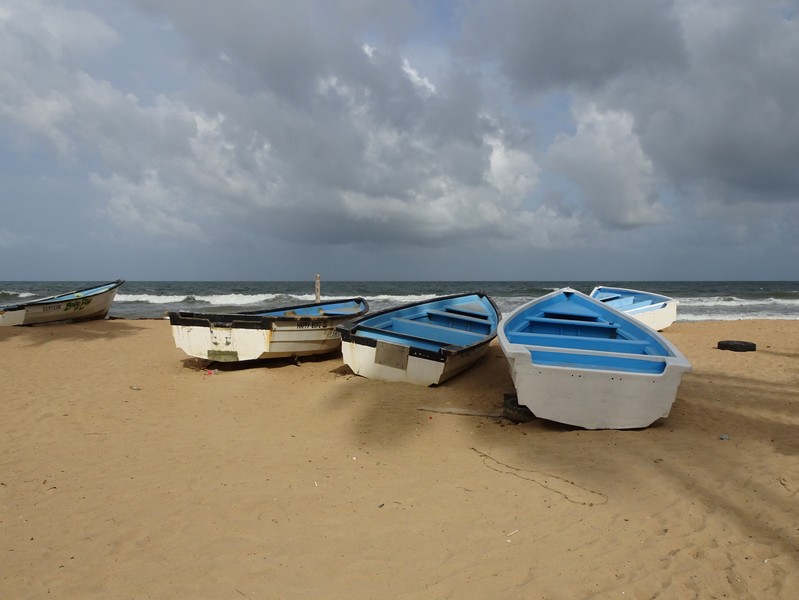
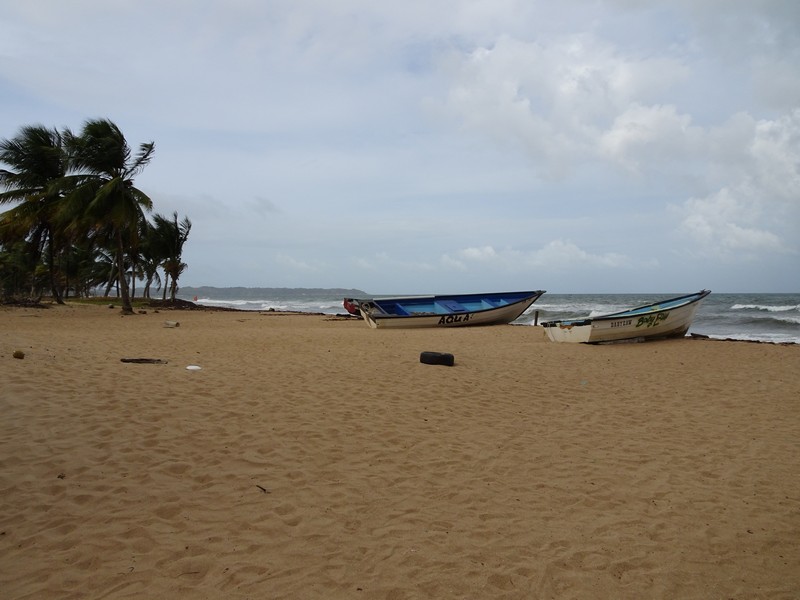
The beach at Mayaro
They finally went at 5.30, and we tried to get sorted. Once again, we felt that we deserved our aperitifs which we had on the veranda.
We cooked the 'skinner' fish we had bought, finding things difficult with no frying pan, and the only saucepans being old, battered 'billy cans'. We ate on the veranda. Again, we were both feeling rather weary!
We cooked the 'skinner' fish we had bought, finding things difficult with no frying pan, and the only saucepans being old, battered 'billy cans'. We ate on the veranda. Again, we were both feeling rather weary!
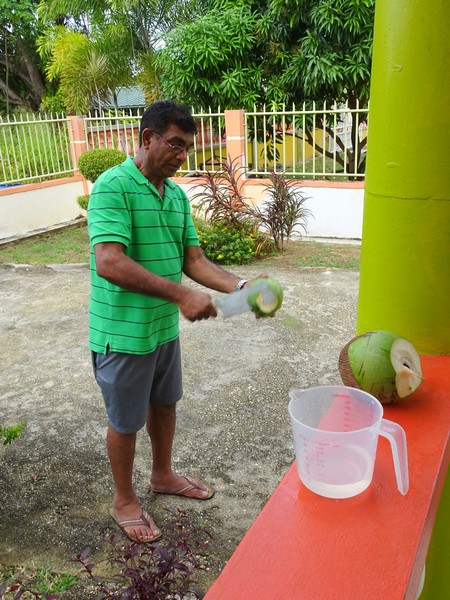
Danpaul (Joe) cutting open a coconut for us
Tuesday 19th February To the extreme Southeast of Trinidad 49 km
We were up early, and spent the morning catching up with diary, website, emails and photos. We enjoyed getting our own breakfast, but with no toaster it was a bit of a challenge - Adrian 'toasted' the bread over the gas ring!
Today was warm but windy. We had breakfast, coffee and lunch on the veranda before leaving at 2.30 to drive to the southeast of Trinidad.
We stopped to view the rough waves - today is full moon. Pelicans looked evocative flying past the palm trees.
We were up early, and spent the morning catching up with diary, website, emails and photos. We enjoyed getting our own breakfast, but with no toaster it was a bit of a challenge - Adrian 'toasted' the bread over the gas ring!
Today was warm but windy. We had breakfast, coffee and lunch on the veranda before leaving at 2.30 to drive to the southeast of Trinidad.
We stopped to view the rough waves - today is full moon. Pelicans looked evocative flying past the palm trees.
On the southeast corner was a narrow peninsula at Galeota, which was all oil and gas country, so a no-go.
There was a habitation nearby, and it was cheering to see the schoolchildren in their uniforms walking home from school. There were some pleasant houses, but generally the area had a forlorn look. The road often had enormous potholes, and there was a lot of subsidence, making for a slow journey.
We drove on, stopping where waves were splashing over the wall. A bit further on we stopped again, near Guayaguayare but were rather aware of the coconut palms above us in the wind!
There was a habitation nearby, and it was cheering to see the schoolchildren in their uniforms walking home from school. There were some pleasant houses, but generally the area had a forlorn look. The road often had enormous potholes, and there was a lot of subsidence, making for a slow journey.
We drove on, stopping where waves were splashing over the wall. A bit further on we stopped again, near Guayaguayare but were rather aware of the coconut palms above us in the wind!
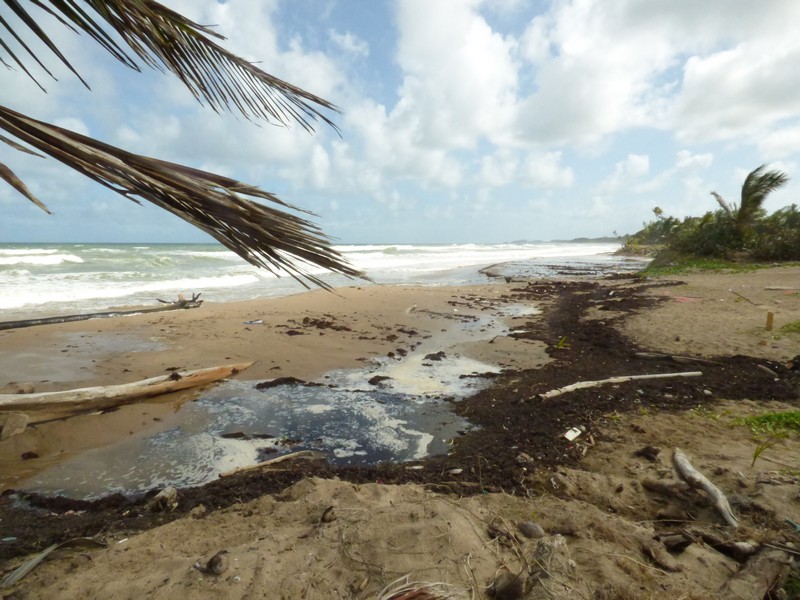
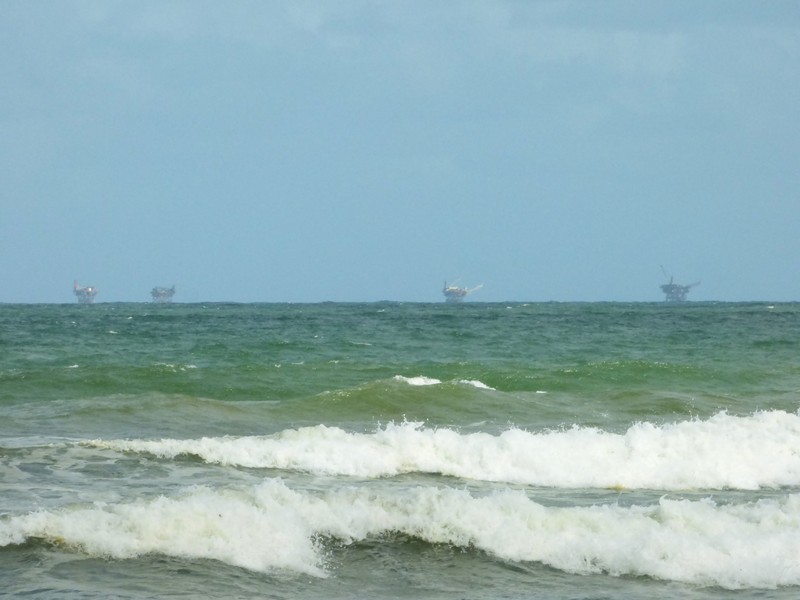
Rough waves in 'oil country' in the south west Trinidad
We were hoping to make this a round trip, following roads on the map, but when we came to a barrier across the road, we had to return. Although it looks like a public road on the map, it 'belonged' to the oil company and probably ran alongside a natural gas pipeline.
Back by the rough waves crashing over the seawall, we stopped to have the cup of tea we'd brought, with some of Arlene's ongoing cake.
Before we stopped at our house, we went down to the beach. The lifeguard was there with his red flag up, as the waves crashed onto the shore. He had tied up one of the fishing boats as with high tide and the neap tide at full moon, the waves were right up around it and it might have got washed out to sea! We chatted a bit while Adrian photographed some more pelicans, getting back just before 5.00pm.
Back by the rough waves crashing over the seawall, we stopped to have the cup of tea we'd brought, with some of Arlene's ongoing cake.
Before we stopped at our house, we went down to the beach. The lifeguard was there with his red flag up, as the waves crashed onto the shore. He had tied up one of the fishing boats as with high tide and the neap tide at full moon, the waves were right up around it and it might have got washed out to sea! We chatted a bit while Adrian photographed some more pelicans, getting back just before 5.00pm.
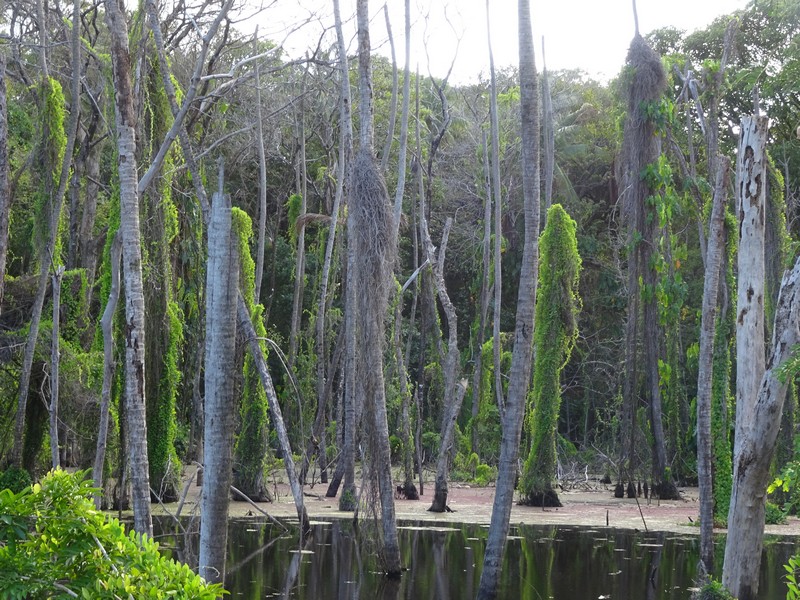
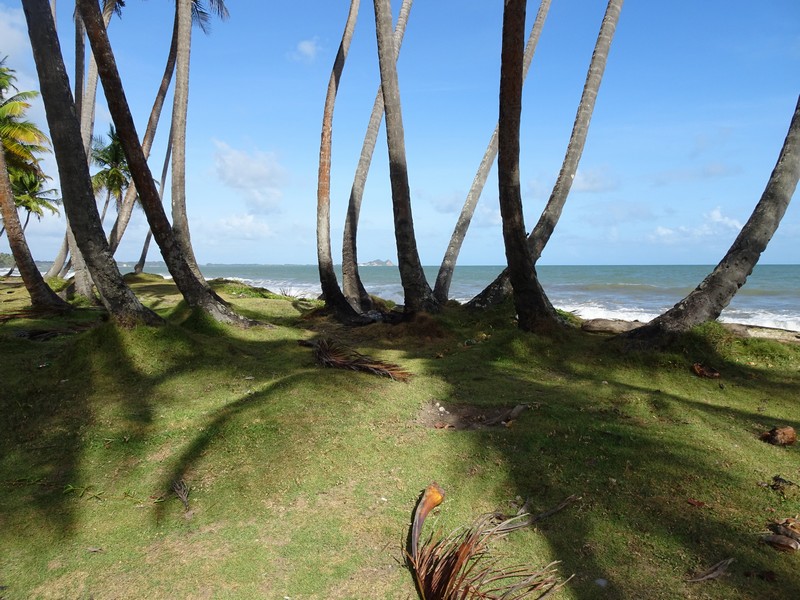
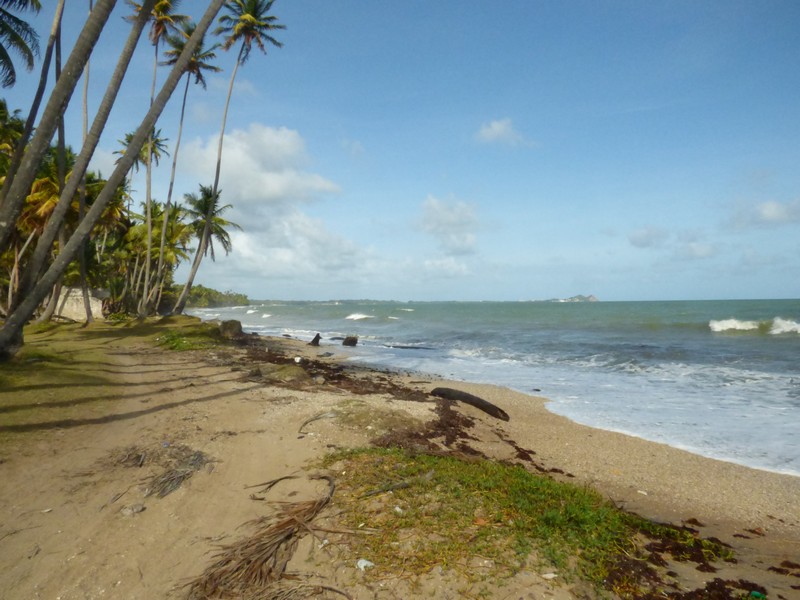
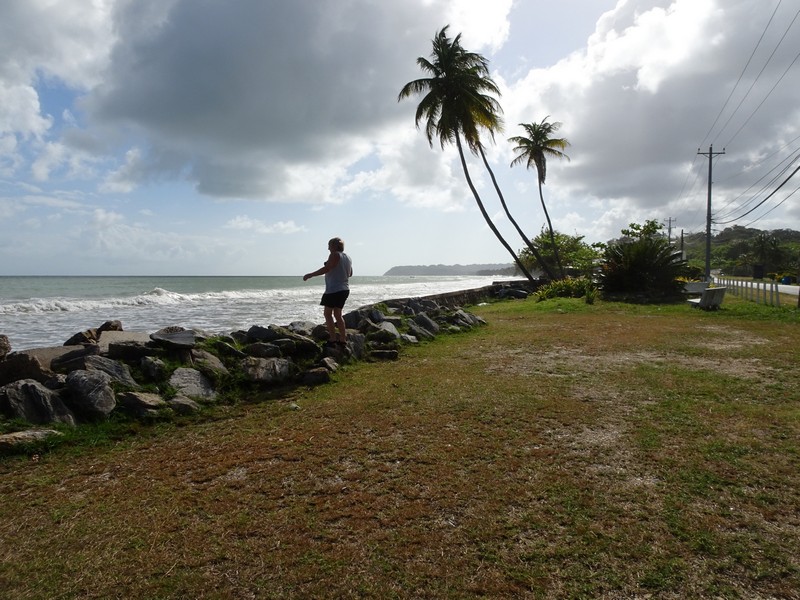
Spooky and evocative south east corner of Trinidad
We had drinks and supper on the veranda, seeing the full moon come up. The worker who’s living upstairs returned from work at Galeota. He greeted us, and reiterated what Joe had said about the oil and gas industry here being in a decline due to the fall in oil prices since 2015.
We got up to date with the website.
We got up to date with the website.
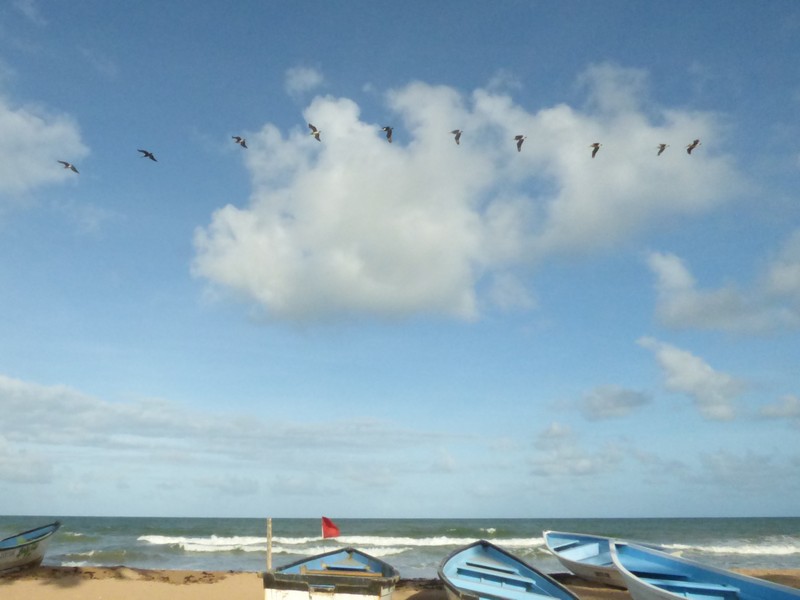
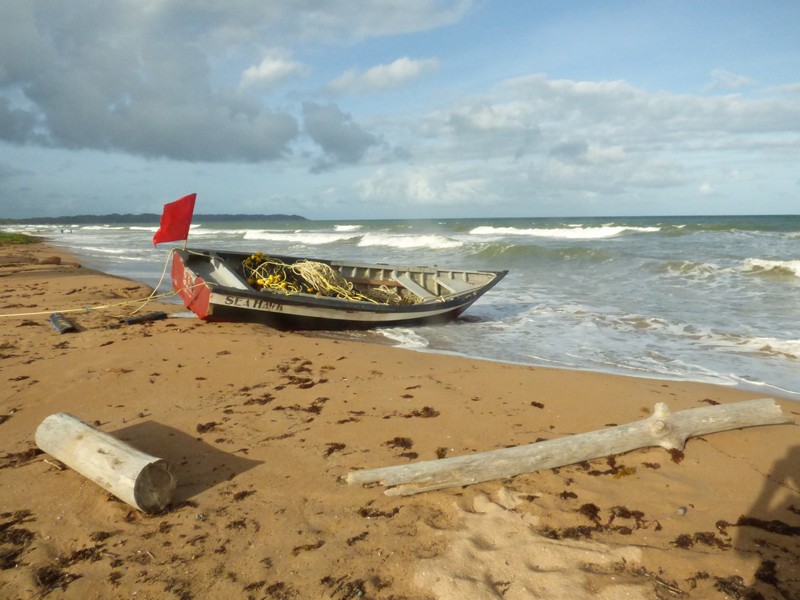
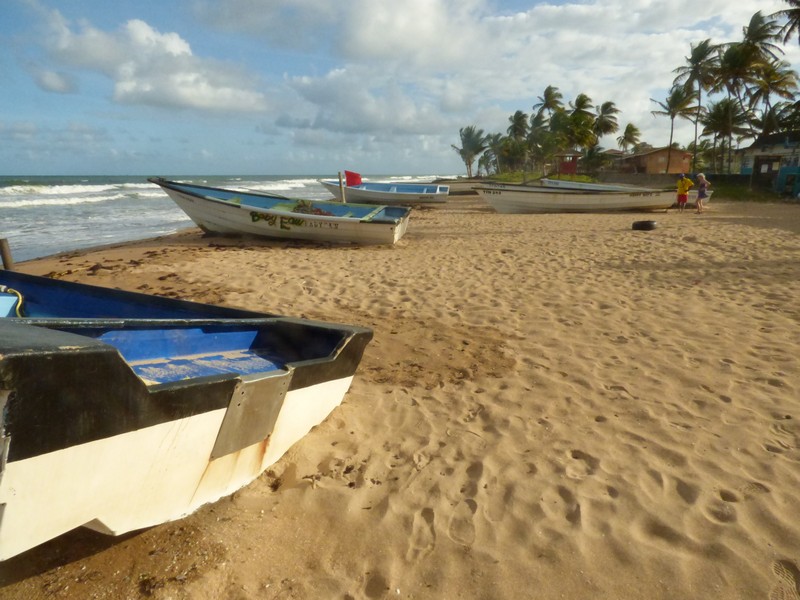
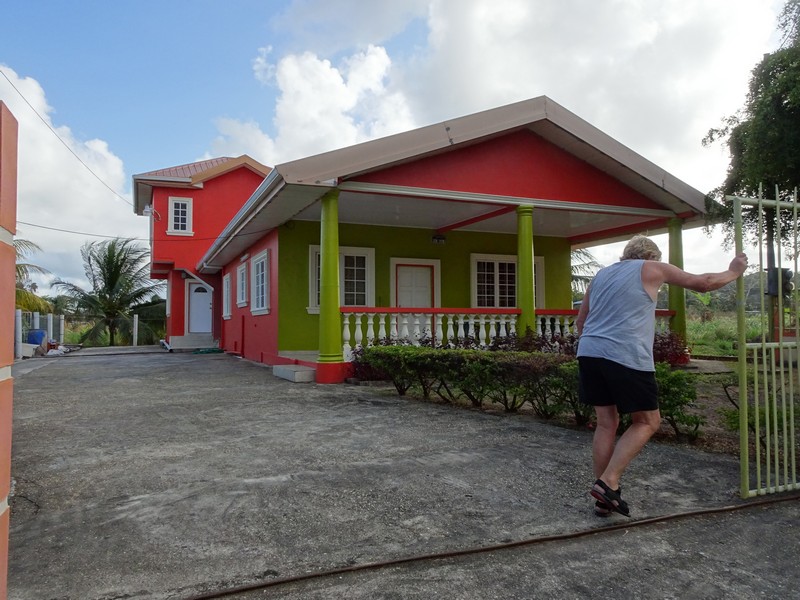
Boats are tied up at 'our' beach as pelicans fly past, then Adrian opens 'our' gate
Wednesday 20th February A quiet last day on Trinidad 48km
It was warm but windy for our last full day in Trinidad. As there was a washing machine here, I decided to use it. The powder didn’t get mixed into the water, but the clothes had a good wash through, and soon dried on the line!
We ate our breakfast on the verandah, and left at 9.20. The worker upstairs had left before 6.00. He hadn’t arrived back until after 6.00pm yesterday – a long day..
We drove through Mayaro, where market stalls were set up with fruit and veg.
We drove northwards as we’d been hoping to see something of the Nariva Swamp, but unfortunately that didn’t happen. Adrian located the place where tours went from – the only way to see anything – and found that the (very expensive) 2 hour tour can only go when the tidal water is deep enough. Unfortunately this meant today it couldn’t start until 3.00pm. That would be too late for us, as we are flying to Tobago tomorrow, and would need to get organised. We were offered a walk, but knew that it would be too much for us poor old biddies, in the warm weather.
Instead we just enjoyed our rural surroundings. We had driven inland to the scattered settlement known as Kernaham village, and made a second route in by a different road. The land was flat. We saw cows and egrets in a field, and genuine old tractors at work. There were some ‘interesting’ houses – one or two grand, but most very simple!
It was warm but windy for our last full day in Trinidad. As there was a washing machine here, I decided to use it. The powder didn’t get mixed into the water, but the clothes had a good wash through, and soon dried on the line!
We ate our breakfast on the verandah, and left at 9.20. The worker upstairs had left before 6.00. He hadn’t arrived back until after 6.00pm yesterday – a long day..
We drove through Mayaro, where market stalls were set up with fruit and veg.
We drove northwards as we’d been hoping to see something of the Nariva Swamp, but unfortunately that didn’t happen. Adrian located the place where tours went from – the only way to see anything – and found that the (very expensive) 2 hour tour can only go when the tidal water is deep enough. Unfortunately this meant today it couldn’t start until 3.00pm. That would be too late for us, as we are flying to Tobago tomorrow, and would need to get organised. We were offered a walk, but knew that it would be too much for us poor old biddies, in the warm weather.
Instead we just enjoyed our rural surroundings. We had driven inland to the scattered settlement known as Kernaham village, and made a second route in by a different road. The land was flat. We saw cows and egrets in a field, and genuine old tractors at work. There were some ‘interesting’ houses – one or two grand, but most very simple!
We’d stopped by the wild sea in the Cocal, sitting on rocks above the golden sandy beach to have coffee, and still going cake from Arlene. We were careful not to sit under the coconut palms! There were no people about.
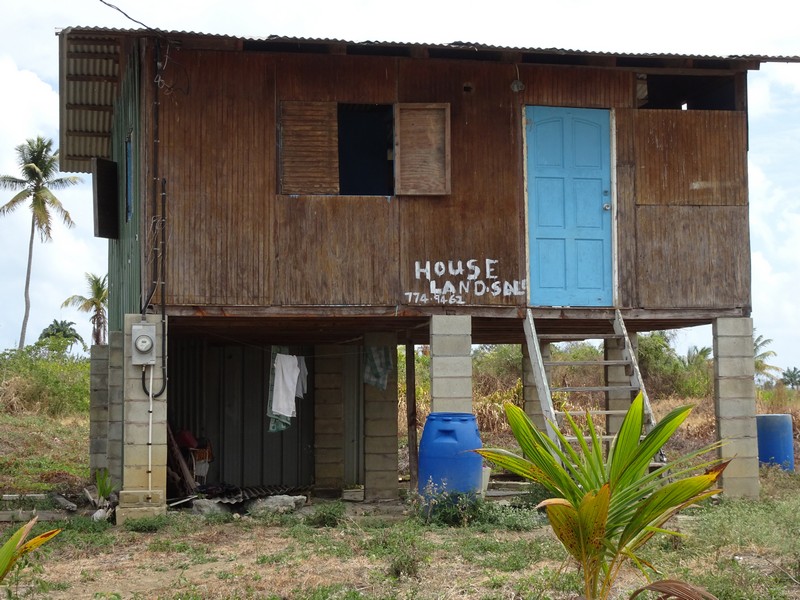
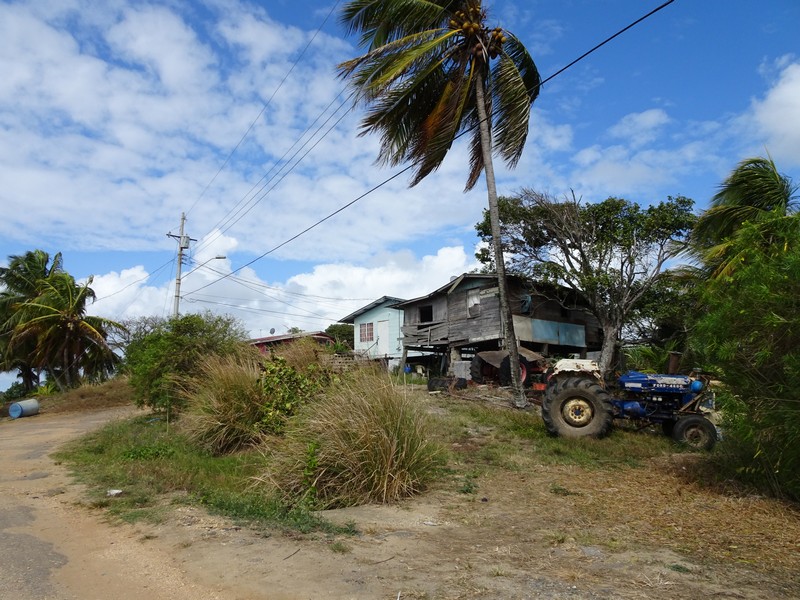
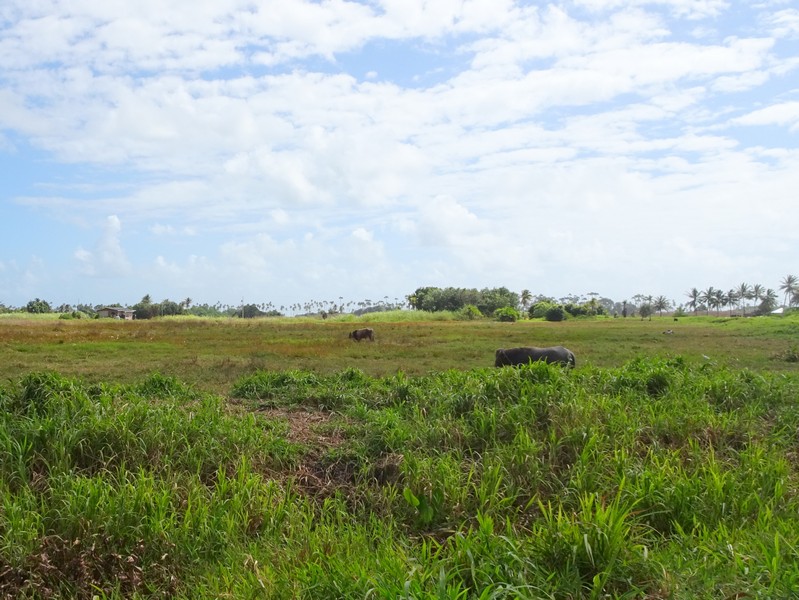
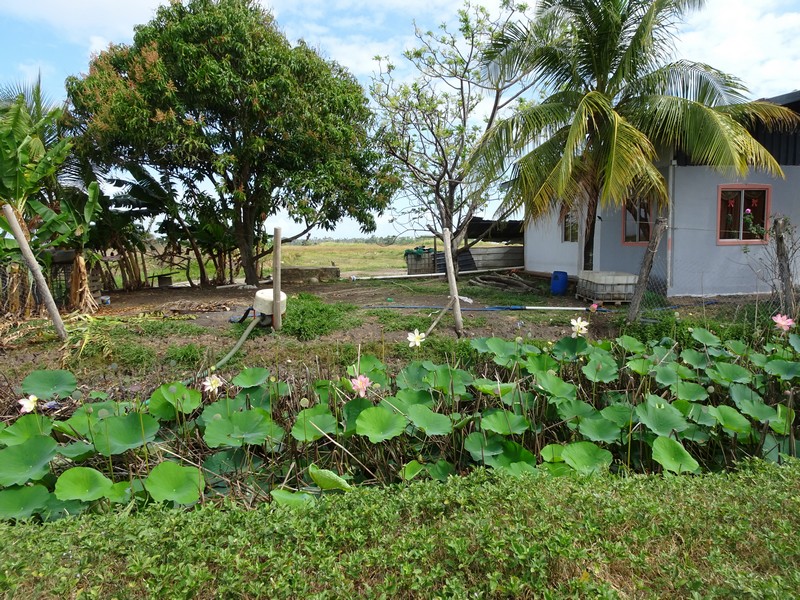
The rural landscape around Kernaham
We passed roadside stalls selling watermelons as we drove back down to Mayora. We stopped by the mouth of the Ortoire River. It was really atmospheric, with its palms and fine sand. A boy and young girl were at the water’s edge, and a man was in the water. We weren’t sure about the large group of vultures gathered!
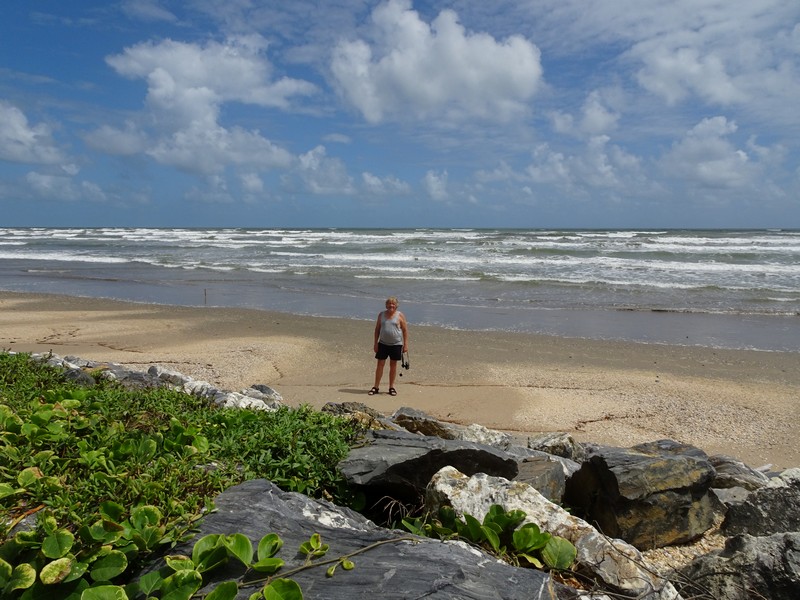
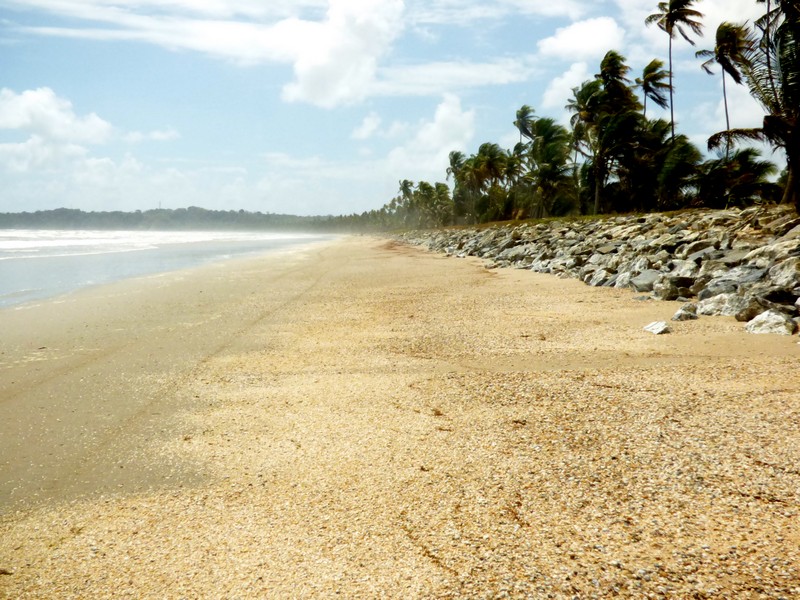
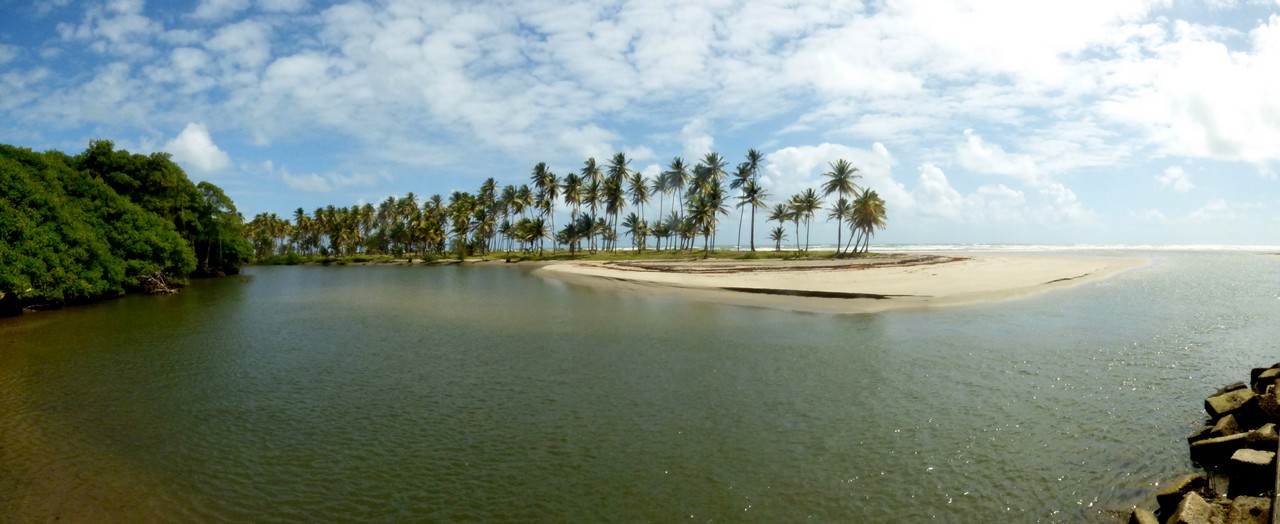
The wild Cocal coast
We drove on a way on the bumpy track, but had to return when we came to a private nature reserve.
At Mayora we stopped by the main beach, which looked very similar to the part by us, with small boats which looked the same.
At Mayora we stopped by the main beach, which looked very similar to the part by us, with small boats which looked the same.
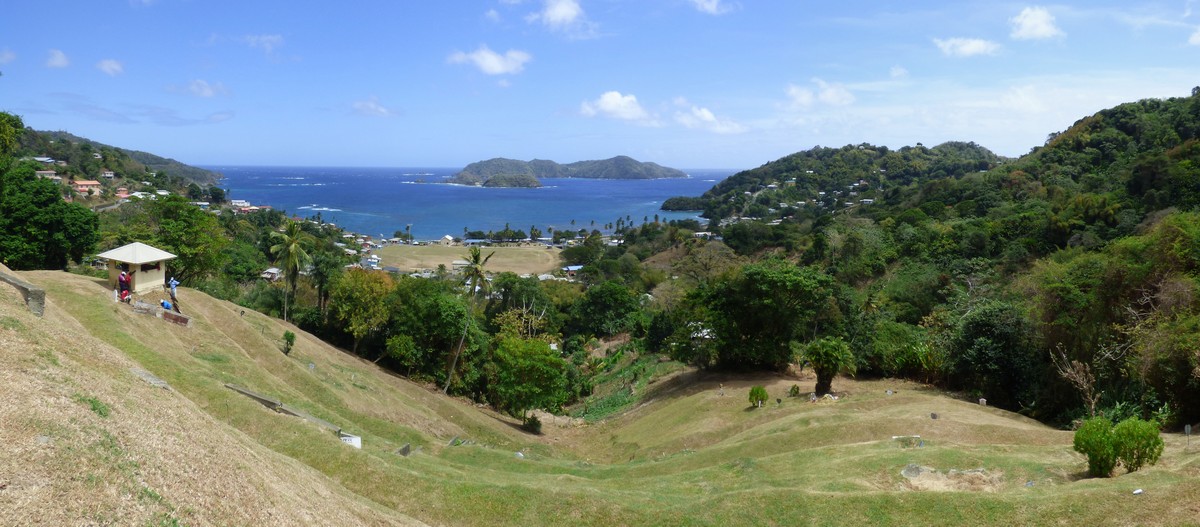
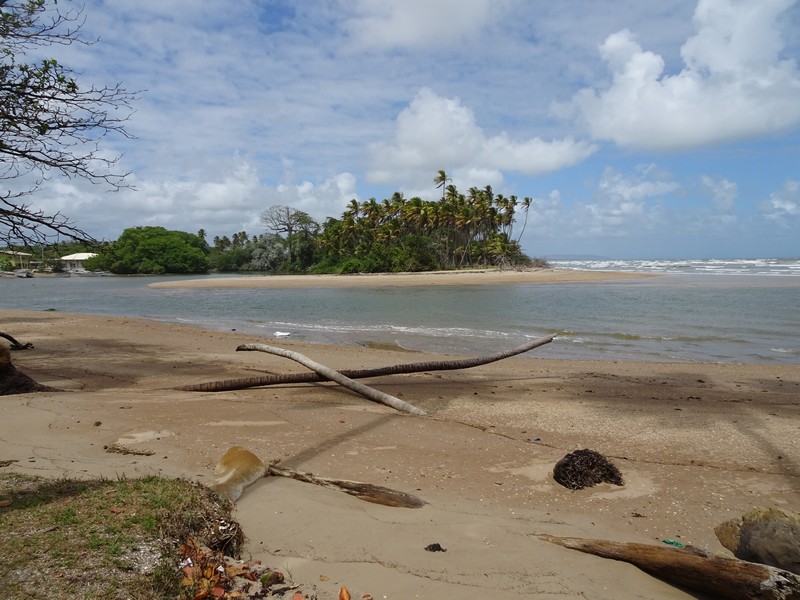
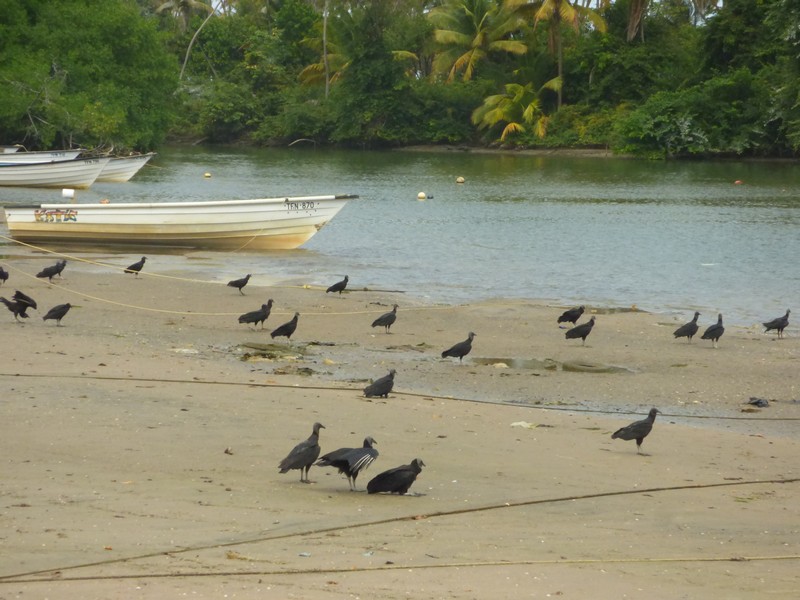
The evocative Ortoire River mouth
We got back at 12.30, and after eating our sandwich on the veranda, got organised for our flight to Tobago tomorrow.
Adrian had a go at chopping his own coconut which we'd picked up by Cocos beach.
Adrian had a go at chopping his own coconut which we'd picked up by Cocos beach.
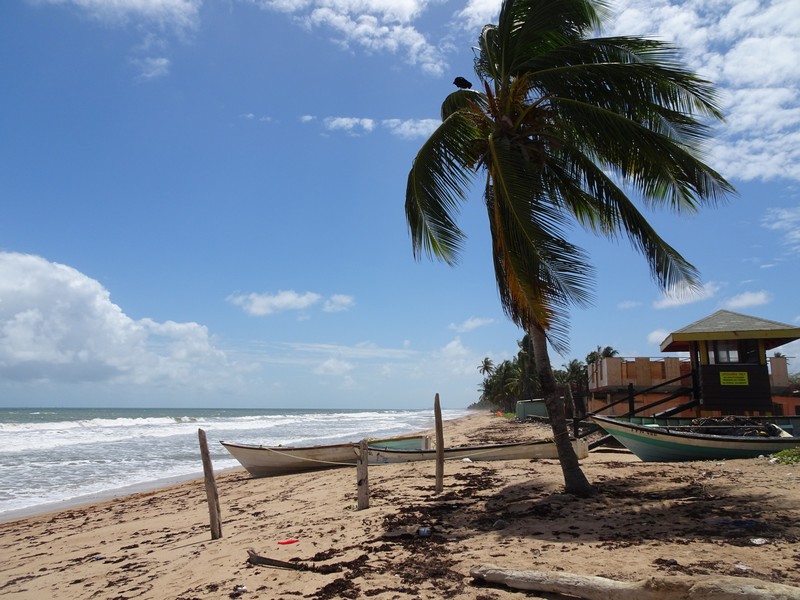
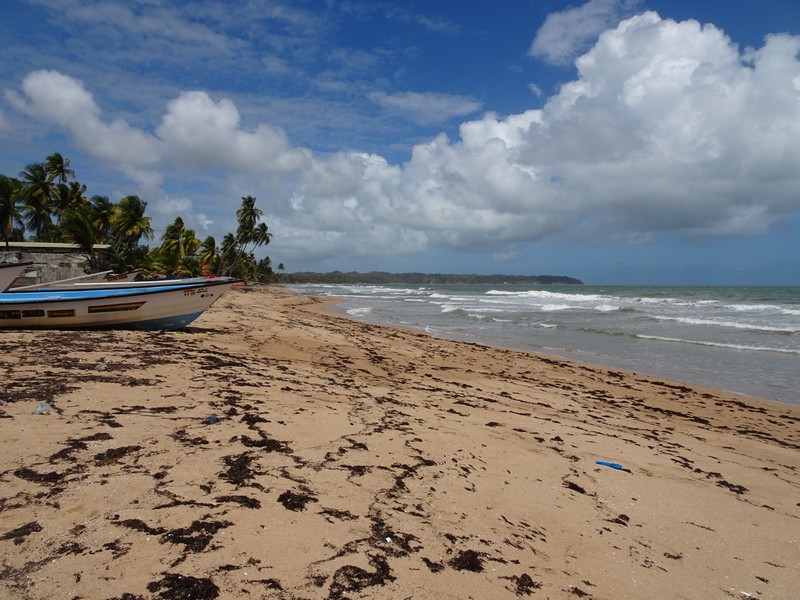
The main beach at Mayora
Later we enjoyed the warmth as we had our drink, then supper, on the veranda.
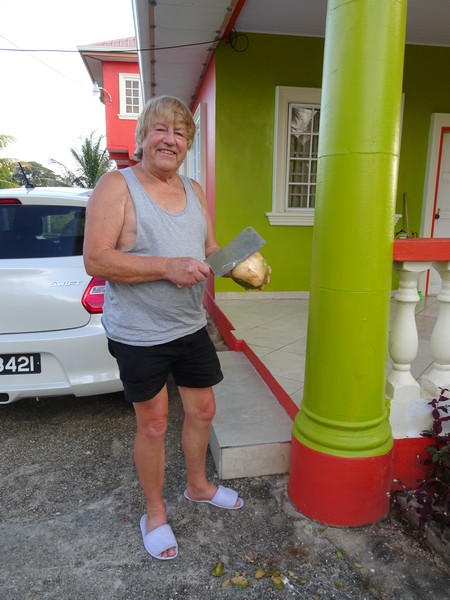
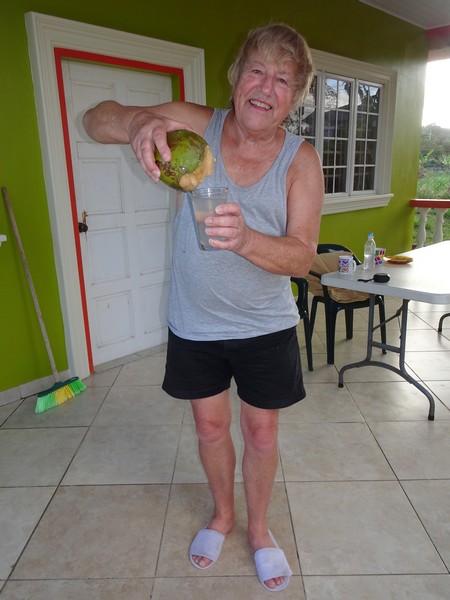
Thursday 21st February To Tobago 86km in Trinidad
We were woken at 4.45 by the tumble drier going, and by heavy rain!
We still got up early to get packed up, and when we had breakfast on the balcony it was warm and sunny. We left before 9.00 am, driving up the east coast. We would have liked to have driven up the middle of the island, but knew that going would be slow, and we had a plane to catch!
Gangs of workers were clearing and tidying the ditches beside the road.
We were woken at 4.45 by the tumble drier going, and by heavy rain!
We still got up early to get packed up, and when we had breakfast on the balcony it was warm and sunny. We left before 9.00 am, driving up the east coast. We would have liked to have driven up the middle of the island, but knew that going would be slow, and we had a plane to catch!
Gangs of workers were clearing and tidying the ditches beside the road.
As we drove through the Cocal, the sea was even rougher than we had seen before. Going was very slow because of the uneven surface of the road, due to subsidence.
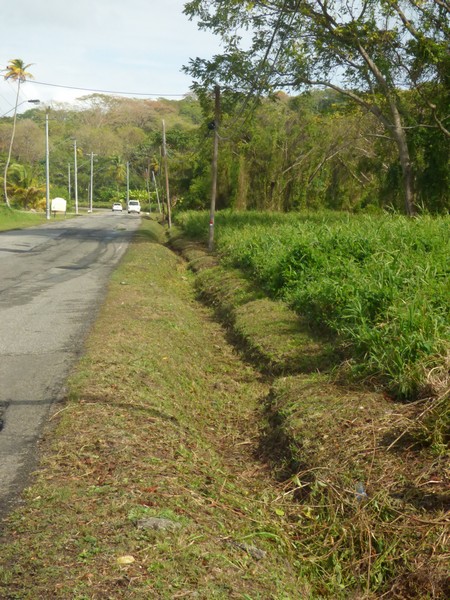
Tidy roadside edges
We decided to make a diversion to Brigand Hill Lighthouse, a few miles off route. The book said that the road went up steeply, and so it did (easily 33% in places) - and for a long time! When we reached the lighthouse, there was just one young chap (and a dog). He was amazed that we got there in a normal car, not a 4x4.
It was very remote, with greenery all around. I think that the chap was glad to have company, and a bit of a diversion. We found him very difficult to understand. Adrian went on to walk up the steps to the lighthouse. High above that were communication towers. It was odd to think of a lighthouse some 3km inland.
It was very remote, with greenery all around. I think that the chap was glad to have company, and a bit of a diversion. We found him very difficult to understand. Adrian went on to walk up the steps to the lighthouse. High above that were communication towers. It was odd to think of a lighthouse some 3km inland.
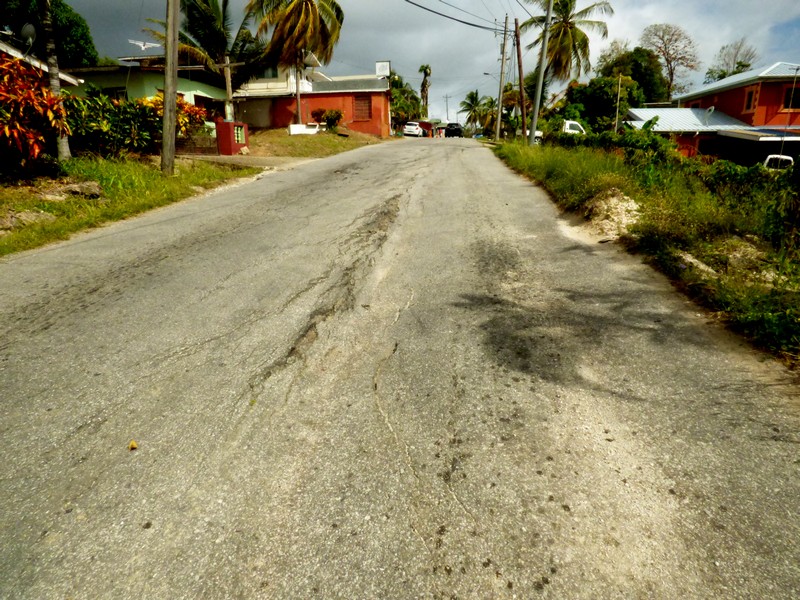
Road subsidence - it isn't obvious but there is an 18 inch drop on one side in the middle of the road
We drove back down, finding nowhere at all to stop. When we finally did, we ate the last piece of cake from Arlene.
We drove on back through busy Sandy Grandy, which was very slow. After that we took the 'fast road' to Piarco airport. We remembered as we got there that we needed to get some fuel, so had to back-track a bit. Adrian found it all very frustrating, as you had to pay first, so again had to decide how much we needed to fill the tank back to ¾ full at a price we didn’t understand. Luckily he got it right first time!
At the airport, the 'Hertz' lady went over everything on the car with a fine tooth comb! She and her companion were very officious - a far cry from the more friendly men when we'd arrived to collect the car.
Security was OK, we walked straight into the departure lounge to await our 2.25pm flight to Tobago.
The plane was full for our half hour flight. When we landed, we just walked across the tarmac to the terminal entrance - and straight into baggage claim, where there was one small carousel.
Reunited with our bags, we walked outside - no immigration or passport control, as Tobago and Trinidad are one country
The message from the car hire firm had said that someone would be waiting by the telephone booth next to the toilets. We located that place. Another couple were waiting there. After some time, a car pulled in, asked if we were 'Brian', then left with the other couple.
We now waited around for a while, then Adrian enquired at the nearby Tourist information, who phoned the car firm. It turned out that the man had taken the other couple, and would be back for us. Very frustrating, as we had a long way to drive, and wanted to get there before dark.
Our chap finally returned. He had a mass of messy tight black curls. He didn't say much as he drove us to a 'compound', where we will return the car. - a deep maroon Nissan Note.
It was now 4.00. We stopped at Penny Market, said to be the best supermarket on the island, but not inspirational to us!
Now 4.45, we started off on the road up the windward side of the island. At first the road was good, as we passed Scarborough, the capital. After that, it was just a continual bend alongside the coast to Speyside. Here we drove across the top corner of the island. The last bit was a hairy, windy, very steep ‘up and down’ to Charlotteville, where we are booked for three nights.
It was just after 6.00, and fortunately not yet dark, as Adrian couldn't find the address of the place he'd booked. He hunted around, finally coming to Top River Pearl apartments. There were lots of steps up - with no hand rail, and no parking. It was the right place - the European owner, Rainer looking a bit like Jaques Cousteau, greeted us, and showed us to our apartment. To Adrian's distress there was no air conditioning - Rainer said it wasn't needed. It was all very basic - one bedroom, small kitchen area with just two gas rings and fridge, and also a loo/shower room. There was two of everything - plates, bowls, cups, cutlery, pillows. No frills or fancies! No toaster again. It then started to rain but fortunately two chaps helped Adrian up with the luggage.
We soon sat on the large lumpy settee on the balcony with a drink!
I cooked shark fillets for supper. It had been another long day!
We drove on back through busy Sandy Grandy, which was very slow. After that we took the 'fast road' to Piarco airport. We remembered as we got there that we needed to get some fuel, so had to back-track a bit. Adrian found it all very frustrating, as you had to pay first, so again had to decide how much we needed to fill the tank back to ¾ full at a price we didn’t understand. Luckily he got it right first time!
At the airport, the 'Hertz' lady went over everything on the car with a fine tooth comb! She and her companion were very officious - a far cry from the more friendly men when we'd arrived to collect the car.
Security was OK, we walked straight into the departure lounge to await our 2.25pm flight to Tobago.
The plane was full for our half hour flight. When we landed, we just walked across the tarmac to the terminal entrance - and straight into baggage claim, where there was one small carousel.
Reunited with our bags, we walked outside - no immigration or passport control, as Tobago and Trinidad are one country
The message from the car hire firm had said that someone would be waiting by the telephone booth next to the toilets. We located that place. Another couple were waiting there. After some time, a car pulled in, asked if we were 'Brian', then left with the other couple.
We now waited around for a while, then Adrian enquired at the nearby Tourist information, who phoned the car firm. It turned out that the man had taken the other couple, and would be back for us. Very frustrating, as we had a long way to drive, and wanted to get there before dark.
Our chap finally returned. He had a mass of messy tight black curls. He didn't say much as he drove us to a 'compound', where we will return the car. - a deep maroon Nissan Note.
It was now 4.00. We stopped at Penny Market, said to be the best supermarket on the island, but not inspirational to us!
Now 4.45, we started off on the road up the windward side of the island. At first the road was good, as we passed Scarborough, the capital. After that, it was just a continual bend alongside the coast to Speyside. Here we drove across the top corner of the island. The last bit was a hairy, windy, very steep ‘up and down’ to Charlotteville, where we are booked for three nights.
It was just after 6.00, and fortunately not yet dark, as Adrian couldn't find the address of the place he'd booked. He hunted around, finally coming to Top River Pearl apartments. There were lots of steps up - with no hand rail, and no parking. It was the right place - the European owner, Rainer looking a bit like Jaques Cousteau, greeted us, and showed us to our apartment. To Adrian's distress there was no air conditioning - Rainer said it wasn't needed. It was all very basic - one bedroom, small kitchen area with just two gas rings and fridge, and also a loo/shower room. There was two of everything - plates, bowls, cups, cutlery, pillows. No frills or fancies! No toaster again. It then started to rain but fortunately two chaps helped Adrian up with the luggage.
We soon sat on the large lumpy settee on the balcony with a drink!
I cooked shark fillets for supper. It had been another long day!
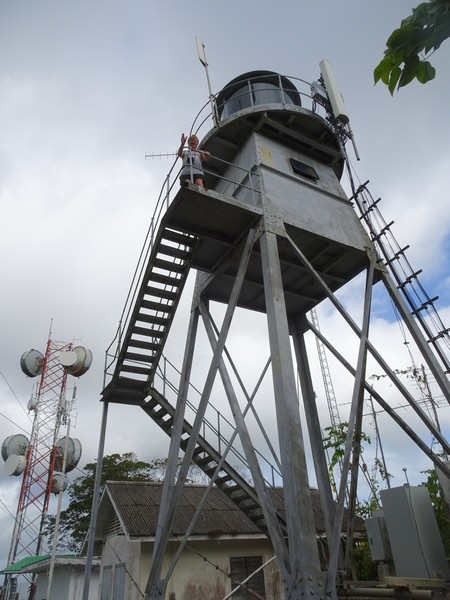
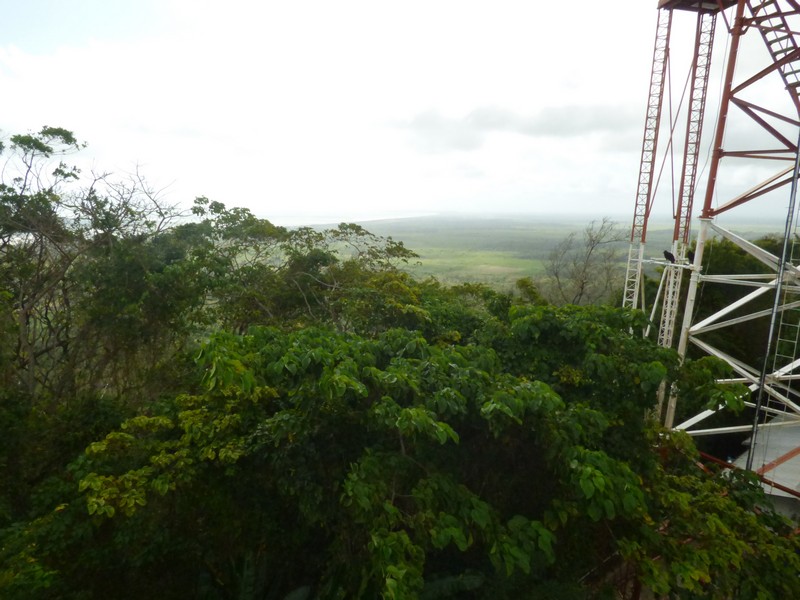
Adrian climbs the steps of the Brigand Hill Lighthouse
Some notes on Trinidad
Trinidad
Contrast between beautiful scenery and frenetic towns
Much more western/North American
Some wider/faster roads
Still plenty of topes (speed humps)
People generally more off hand – eg in supermarkets
Trinidad is/was much wealthier than the first three islands due to oil revenues
Resulted in far more cars
Now suffering from depression due to lower world oil prices
Valley Oasis Inn
No house name label again
Quirky
OTT friendly, helpful owner Arlene
Pleasant husband and sons
Large room
Small balcony
Kitchen sink up steps
Crockery cupboard on stairs – difficult
Bathroom sink –smart bowl on table
Shelf in bathroom
Generous OTT breakfast included each morning
Lovely small private swimming pool
Moraya ( south)
No name for house
Air b&b hadn’t informed owner until recently of our booking
We weren’t in expected apartment – their personal one
Owner Joe pleasant -’use anything you want to’
Lots of stuff everywhere – fridge and cupboard
New towels and sheets
No toaster or frying pan
Huge gas hob- 6 rings, but few matches
Short distance from (rough) sea
No bedside table
Battered old saucepans
Nowhere in bathroom to hang towels
Plethora of green plastic stackable chairs
Two large plastic tables
Trinidad
Contrast between beautiful scenery and frenetic towns
Much more western/North American
Some wider/faster roads
Still plenty of topes (speed humps)
People generally more off hand – eg in supermarkets
Trinidad is/was much wealthier than the first three islands due to oil revenues
Resulted in far more cars
Now suffering from depression due to lower world oil prices
Valley Oasis Inn
No house name label again
Quirky
OTT friendly, helpful owner Arlene
Pleasant husband and sons
Large room
Small balcony
Kitchen sink up steps
Crockery cupboard on stairs – difficult
Bathroom sink –smart bowl on table
Shelf in bathroom
Generous OTT breakfast included each morning
Lovely small private swimming pool
Moraya ( south)
No name for house
Air b&b hadn’t informed owner until recently of our booking
We weren’t in expected apartment – their personal one
Owner Joe pleasant -’use anything you want to’
Lots of stuff everywhere – fridge and cupboard
New towels and sheets
No toaster or frying pan
Huge gas hob- 6 rings, but few matches
Short distance from (rough) sea
No bedside table
Battered old saucepans
Nowhere in bathroom to hang towels
Plethora of green plastic stackable chairs
Two large plastic tables
Trinidad









